 Nvidia Supporting Local Communities NVIDIA employees joined the company in contributing more than USD22 million and 16,500 volunteer hours to charitable causes in fiscal year 2022.[1] The company and its employees supported 5,700 nonprofits in 50+ countries around the world. Nearly 40% of employees participated in the Foundation’s Inspire 365 efforts during FY22, bringing the unique participation rate since the initiative’s start to 68%. Nvidia and Gender Equality and Minorities As of January 30, 2022, the company’s global workforce was 80% male, 19% female, and 1% not declared and 6% of workforce in the United States was composed of Black or African American and Hispanic or Latino employees.[2] The company scored 100% on the Human Rights Campaign’s Corporate Equality Index for a seventh consecutive year Energy Consumption by Nvidia By the end of the fiscal year ending January 31, 2025, the company plans to purchase or generate enough renewable energy to match 100% of its global electricity usage for its offices and data centres Waste Reduction and Recycling by Nvidia The company diverted 56% of FY22 waste from landfill, a 12 percentage point decrease from the previous year. Bulk carton packaging uses corrugate material that is 100% recycled fibres, and the cartons maintain an overall recyclability rate of 100% Consumer packaging uses 70% recycled fibres and maintains a recyclability rate above 75%. Overall recyclability rate for all packaging is 93% Nvidia other CSR Initiatives and Charitable Donations The company donated more than USD4.6 million to date for humanitarian relief to Ukraine and its refugees.[3] Nvidia Corporation Report contains a full analysis of Nvidia corporate social responsibility including Nvidia CSR issues. The report illustrates the application of the major analytical strategic frameworks in business studies such as SWOT, PESTEL, Porter’s Five Forces, Value Chain analysis, Ansoff…
Nvidia Supporting Local Communities NVIDIA employees joined the company in contributing more than USD22 million and 16,500 volunteer hours to charitable causes in fiscal year 2022.[1] The company and its employees supported 5,700 nonprofits in 50+ countries around the world. Nearly 40% of employees participated in the Foundation’s Inspire 365 efforts during FY22, bringing the unique participation rate since the initiative’s start to 68%. Nvidia and Gender Equality and Minorities As of January 30, 2022, the company’s global workforce was 80% male, 19% female, and 1% not declared and 6% of workforce in the United States was composed of Black or African American and Hispanic or Latino employees.[2] The company scored 100% on the Human Rights Campaign’s Corporate Equality Index for a seventh consecutive year Energy Consumption by Nvidia By the end of the fiscal year ending January 31, 2025, the company plans to purchase or generate enough renewable energy to match 100% of its global electricity usage for its offices and data centres Waste Reduction and Recycling by Nvidia The company diverted 56% of FY22 waste from landfill, a 12 percentage point decrease from the previous year. Bulk carton packaging uses corrugate material that is 100% recycled fibres, and the cartons maintain an overall recyclability rate of 100% Consumer packaging uses 70% recycled fibres and maintains a recyclability rate above 75%. Overall recyclability rate for all packaging is 93% Nvidia other CSR Initiatives and Charitable Donations The company donated more than USD4.6 million to date for humanitarian relief to Ukraine and its refugees.[3] Nvidia Corporation Report contains a full analysis of Nvidia corporate social responsibility including Nvidia CSR issues. The report illustrates the application of the major analytical strategic frameworks in business studies such as SWOT, PESTEL, Porter’s Five Forces, Value Chain analysis, Ansoff…Specialized on Data processing, Data management Implementation plan, Data Collection tools - electronic and paper base, Data cleaning specifications, Data extraction, Data transformation, Data load, Analytical Datasets, and Data analysis. BJ Data Tech Solutions teaches on design and developing Electronic Data Collection Tools using CSPro, and STATA commands for data manipulation. Setting up Data Management systems using modern data technologies such as Relational Databases, C#, PHP and Android.
Tuesday, November 21, 2023
Nvidia CSR Overview
 Nvidia Supporting Local Communities NVIDIA employees joined the company in contributing more than USD22 million and 16,500 volunteer hours to charitable causes in fiscal year 2022.[1] The company and its employees supported 5,700 nonprofits in 50+ countries around the world. Nearly 40% of employees participated in the Foundation’s Inspire 365 efforts during FY22, bringing the unique participation rate since the initiative’s start to 68%. Nvidia and Gender Equality and Minorities As of January 30, 2022, the company’s global workforce was 80% male, 19% female, and 1% not declared and 6% of workforce in the United States was composed of Black or African American and Hispanic or Latino employees.[2] The company scored 100% on the Human Rights Campaign’s Corporate Equality Index for a seventh consecutive year Energy Consumption by Nvidia By the end of the fiscal year ending January 31, 2025, the company plans to purchase or generate enough renewable energy to match 100% of its global electricity usage for its offices and data centres Waste Reduction and Recycling by Nvidia The company diverted 56% of FY22 waste from landfill, a 12 percentage point decrease from the previous year. Bulk carton packaging uses corrugate material that is 100% recycled fibres, and the cartons maintain an overall recyclability rate of 100% Consumer packaging uses 70% recycled fibres and maintains a recyclability rate above 75%. Overall recyclability rate for all packaging is 93% Nvidia other CSR Initiatives and Charitable Donations The company donated more than USD4.6 million to date for humanitarian relief to Ukraine and its refugees.[3] Nvidia Corporation Report contains a full analysis of Nvidia corporate social responsibility including Nvidia CSR issues. The report illustrates the application of the major analytical strategic frameworks in business studies such as SWOT, PESTEL, Porter’s Five Forces, Value Chain analysis, Ansoff…
Nvidia Supporting Local Communities NVIDIA employees joined the company in contributing more than USD22 million and 16,500 volunteer hours to charitable causes in fiscal year 2022.[1] The company and its employees supported 5,700 nonprofits in 50+ countries around the world. Nearly 40% of employees participated in the Foundation’s Inspire 365 efforts during FY22, bringing the unique participation rate since the initiative’s start to 68%. Nvidia and Gender Equality and Minorities As of January 30, 2022, the company’s global workforce was 80% male, 19% female, and 1% not declared and 6% of workforce in the United States was composed of Black or African American and Hispanic or Latino employees.[2] The company scored 100% on the Human Rights Campaign’s Corporate Equality Index for a seventh consecutive year Energy Consumption by Nvidia By the end of the fiscal year ending January 31, 2025, the company plans to purchase or generate enough renewable energy to match 100% of its global electricity usage for its offices and data centres Waste Reduction and Recycling by Nvidia The company diverted 56% of FY22 waste from landfill, a 12 percentage point decrease from the previous year. Bulk carton packaging uses corrugate material that is 100% recycled fibres, and the cartons maintain an overall recyclability rate of 100% Consumer packaging uses 70% recycled fibres and maintains a recyclability rate above 75%. Overall recyclability rate for all packaging is 93% Nvidia other CSR Initiatives and Charitable Donations The company donated more than USD4.6 million to date for humanitarian relief to Ukraine and its refugees.[3] Nvidia Corporation Report contains a full analysis of Nvidia corporate social responsibility including Nvidia CSR issues. The report illustrates the application of the major analytical strategic frameworks in business studies such as SWOT, PESTEL, Porter’s Five Forces, Value Chain analysis, Ansoff…Friday, October 27, 2023
Marriott McKinsey 7S Model
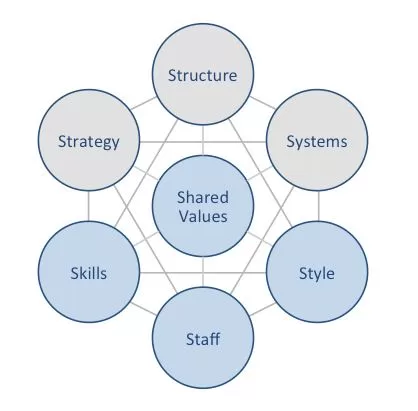 Marriott McKinsey 7S model illustrates the ways in which seven elements of businesses can be aligned to increase effectiveness for the largest hotel chain in the world. According to this framework strategy, structure and systems represent hard elements, whereas shared values, skills, style and staff are soft elements. McKinsey 7S model stresses the presence of strong links between elements in a way that a change in one element causes changes in others. As it is illustrated in figure below, shared values are positioned at the core of Marriott McKinsey 7S model, since shared values guide employee behaviour with implications on their performance. McKinsey 7S model Hard Elements in Marriott McKinsey 7S Model Strategy Marriott International’s business strategy is focused on providing high-quality hospitality services to a wide range of customers. The company has a portfolio of over 30 brands, ranging from budget-friendly to luxury, to appeal to different needs and budgets.[1] The hotel chain pursues asset-light business model and growth through acquisitions business strategy. Moreover, Marriott has been focusing on bleisure travellers as part of its business strategy. Structure Marriott International has a decentralized organizational structure, with each brand operating as its own business unit. This allows the company to tailor its offerings and services to the specific needs of each market. Marriott also has a strong focus on operational excellence, with a number of systems and processes in place to ensure that its hotels are run efficiently and effectively. Systems Marriott International has a number of systems in place to support its business operations, including a reservation system, a loyalty program, and a property management system. The company is also investing heavily in new technologies, such as mobile check-in and self-service kiosks. Marriott International Inc. Report contains a full analysis of Marriott McKinsey 7S Model.…
Marriott McKinsey 7S model illustrates the ways in which seven elements of businesses can be aligned to increase effectiveness for the largest hotel chain in the world. According to this framework strategy, structure and systems represent hard elements, whereas shared values, skills, style and staff are soft elements. McKinsey 7S model stresses the presence of strong links between elements in a way that a change in one element causes changes in others. As it is illustrated in figure below, shared values are positioned at the core of Marriott McKinsey 7S model, since shared values guide employee behaviour with implications on their performance. McKinsey 7S model Hard Elements in Marriott McKinsey 7S Model Strategy Marriott International’s business strategy is focused on providing high-quality hospitality services to a wide range of customers. The company has a portfolio of over 30 brands, ranging from budget-friendly to luxury, to appeal to different needs and budgets.[1] The hotel chain pursues asset-light business model and growth through acquisitions business strategy. Moreover, Marriott has been focusing on bleisure travellers as part of its business strategy. Structure Marriott International has a decentralized organizational structure, with each brand operating as its own business unit. This allows the company to tailor its offerings and services to the specific needs of each market. Marriott also has a strong focus on operational excellence, with a number of systems and processes in place to ensure that its hotels are run efficiently and effectively. Systems Marriott International has a number of systems in place to support its business operations, including a reservation system, a loyalty program, and a property management system. The company is also investing heavily in new technologies, such as mobile check-in and self-service kiosks. Marriott International Inc. Report contains a full analysis of Marriott McKinsey 7S Model.…Marriott Value Chain Analysis
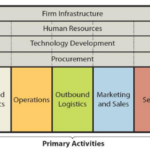 Value chain analysis is an analytical tool that helps to find business activities that can create the most value and competitive advantage to the business. Figure below illustrates the essence of Marriott value chain analysis. Marriott Value Chain Analysis Marriott Primary Activities Marriott Inbound logistics The inbound logistics activities for Marriott International involve the procurement, transportation, and storage of the goods and services that the company needs to operate its hotels and resorts. These activities are essential to the company’s ability to provide its guests with a high-quality experience. Marriott International procures a wide range of goods and services from suppliers such as food and beverage, linen, furniture, toiletries and other supplies. The largest hotel chain in the world has a strong supplier network and is able to negotiate competitive prices. The company also has a team of experienced procurement professionals who are responsible for managing the inbound logistics process. Marriott Operations Marriott’s operations can be divided into four key areas: 1. Hotels. Marriott operates and franchises hotels under its various brands. It also manages hotels on behalf of other owners. 2. Vacation ownership. Marriott operates a vacation ownership program called Marriott Vacation Club International. This program allows members to purchase vacation points that can be used to stay at Marriott-affiliated vacation resorts. 3. Timeshare exchange. Marriott operates Interval International, a timeshare exchange program that allows members to swap their timeshare weeks for stays at other resorts. 4. Food and beverage. Marriott operates restaurants and bars in many of its hotels. It also provides catering services. Marriott Outbound Logistics Generally, outbound logistics within value chain analysis refer to all the activities involved in delivering the finished product or service to the customer. This includes warehousing, order fulfilment, transportation, and delivery. For Marriott International outbound logistics activities include the following:…
Value chain analysis is an analytical tool that helps to find business activities that can create the most value and competitive advantage to the business. Figure below illustrates the essence of Marriott value chain analysis. Marriott Value Chain Analysis Marriott Primary Activities Marriott Inbound logistics The inbound logistics activities for Marriott International involve the procurement, transportation, and storage of the goods and services that the company needs to operate its hotels and resorts. These activities are essential to the company’s ability to provide its guests with a high-quality experience. Marriott International procures a wide range of goods and services from suppliers such as food and beverage, linen, furniture, toiletries and other supplies. The largest hotel chain in the world has a strong supplier network and is able to negotiate competitive prices. The company also has a team of experienced procurement professionals who are responsible for managing the inbound logistics process. Marriott Operations Marriott’s operations can be divided into four key areas: 1. Hotels. Marriott operates and franchises hotels under its various brands. It also manages hotels on behalf of other owners. 2. Vacation ownership. Marriott operates a vacation ownership program called Marriott Vacation Club International. This program allows members to purchase vacation points that can be used to stay at Marriott-affiliated vacation resorts. 3. Timeshare exchange. Marriott operates Interval International, a timeshare exchange program that allows members to swap their timeshare weeks for stays at other resorts. 4. Food and beverage. Marriott operates restaurants and bars in many of its hotels. It also provides catering services. Marriott Outbound Logistics Generally, outbound logistics within value chain analysis refer to all the activities involved in delivering the finished product or service to the customer. This includes warehousing, order fulfilment, transportation, and delivery. For Marriott International outbound logistics activities include the following:…Marriott Porter’s Five Forces Analysis
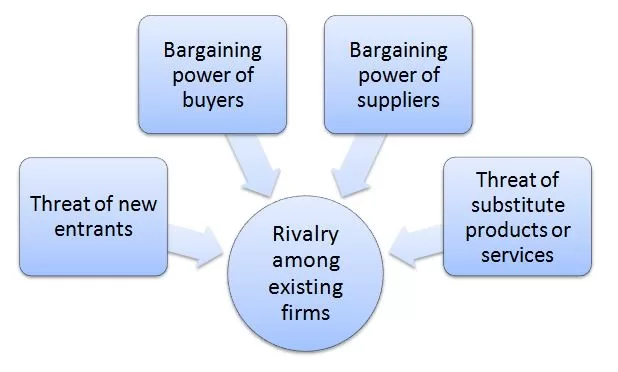 Porter’s Five Forces analytical framework developed by Michael Porter (1979)[1] represents five individual forces that shape an overall extent of competition in the industry. These forces are illustrated in figure below: Porter’s Five Forces Threat of new entrants in Marriott Porter’s Five Forces Analysis The threat of new entrants into the global hotel industry is moderate. There are a number of factors that make it difficult for new entrants to enter the hotel industry. These include high capital requirements, the importance of brand recognition, lack of access to distribution channels and the importance of economies of scale. Capital requirements The hotel industry is highly capital-intensive. New entrants need to have a significant amount of capital to invest in building or acquiring hotels. According to data from hospitality consulting firm HVS, ground up construction of a full-service hotel typically costs USD 323,500 per room in the US.[2] The similar pattern is echoed in many other markets as well. Accordingly, capital requirements are a significant entry barrier for new players into the hotel industry. Brand recognition Established hotel brands such as Marriott, Hilton, IHG Hotels & Resorts, Hyatt and Wyndham Hotels & Resorts have a significant advantage over new entrants. These companies have been developing and promoting their brands for decades and accordingly, have a strong reputation and customer loyalty. Moreover, effective branding enables established market players to command premium prices, further solidifying their position. New entrants, on the other hand, will have no visible brand, making it difficult for them to successes in the market. Distribution channels Distribution channels for hotels include direct channels, such as their own websites and reservation call centres, and indirect channels, such as online travel agencies (OTAs), global distribution systems (GDSs), and tour operators. Established hotel brands such as Marriott have well-established distribution channels.…
Porter’s Five Forces analytical framework developed by Michael Porter (1979)[1] represents five individual forces that shape an overall extent of competition in the industry. These forces are illustrated in figure below: Porter’s Five Forces Threat of new entrants in Marriott Porter’s Five Forces Analysis The threat of new entrants into the global hotel industry is moderate. There are a number of factors that make it difficult for new entrants to enter the hotel industry. These include high capital requirements, the importance of brand recognition, lack of access to distribution channels and the importance of economies of scale. Capital requirements The hotel industry is highly capital-intensive. New entrants need to have a significant amount of capital to invest in building or acquiring hotels. According to data from hospitality consulting firm HVS, ground up construction of a full-service hotel typically costs USD 323,500 per room in the US.[2] The similar pattern is echoed in many other markets as well. Accordingly, capital requirements are a significant entry barrier for new players into the hotel industry. Brand recognition Established hotel brands such as Marriott, Hilton, IHG Hotels & Resorts, Hyatt and Wyndham Hotels & Resorts have a significant advantage over new entrants. These companies have been developing and promoting their brands for decades and accordingly, have a strong reputation and customer loyalty. Moreover, effective branding enables established market players to command premium prices, further solidifying their position. New entrants, on the other hand, will have no visible brand, making it difficult for them to successes in the market. Distribution channels Distribution channels for hotels include direct channels, such as their own websites and reservation call centres, and indirect channels, such as online travel agencies (OTAs), global distribution systems (GDSs), and tour operators. Established hotel brands such as Marriott have well-established distribution channels.…Marriott Marketing Strategy
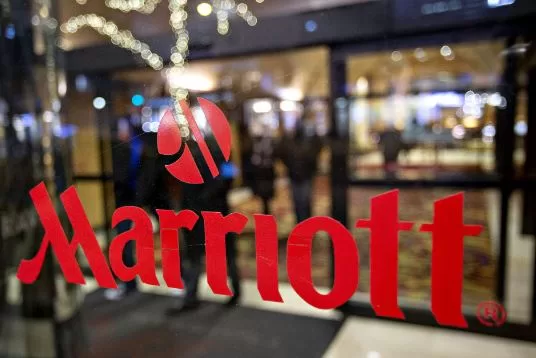 Marriott marketing strategy is designed to reach its target audience of travellers and to encourage them to book a stay at a hotel or resort belonging to it portfolio. Marketing costs for the largest hotel chain in the world amounted to USD 635 million in 2022, USD 470 million in 2021, and USD 276 million in 2020[1]. Marriott marketing strategy focuses on the following key elements: – Brand differentiation. Marriott International differentiates its brand from other hotel companies by emphasizing its commitment to quality, service, and innovation. The company also offers a wide range of hotel brands to suit the needs of different travellers, from budget-minded travellers to luxury travellers. – Unique selling proposition. Along with its world-class amenities, commitment to customer services is unique selling proposition for Marriott hotels. Employees are trained to go the extra mile to make guests feel welcome and valued. – Customer segmentation. Marriott International segments its customers into different groups based on their travel needs and preferences. This allows the company to develop targeted marketing campaigns that are relevant to each segment. – Omni-channel marketing. Marriott International uses a variety of marketing channels to reach its target audience, including online, offline, and social media. The company also integrates its marketing campaigns across all channels to provide a seamless customer experience. – Product placement strategy. Product placement is one of the key elements of Marriott marketing strategy. One of Marriott’s most famous product placement deals was with the popular TV show “The Real Housewives of Beverly Hills.” The show featured the cast staying at the Ritz-Carlton, Los Angeles on several occasions. This exposure helped to position the Ritz-Carlton as a luxury hotel brand that was popular with celebrities and other high-profile individuals. Marriott has also placed its hotels in a number of successful movies, including “The Devil Wears…
Marriott marketing strategy is designed to reach its target audience of travellers and to encourage them to book a stay at a hotel or resort belonging to it portfolio. Marketing costs for the largest hotel chain in the world amounted to USD 635 million in 2022, USD 470 million in 2021, and USD 276 million in 2020[1]. Marriott marketing strategy focuses on the following key elements: – Brand differentiation. Marriott International differentiates its brand from other hotel companies by emphasizing its commitment to quality, service, and innovation. The company also offers a wide range of hotel brands to suit the needs of different travellers, from budget-minded travellers to luxury travellers. – Unique selling proposition. Along with its world-class amenities, commitment to customer services is unique selling proposition for Marriott hotels. Employees are trained to go the extra mile to make guests feel welcome and valued. – Customer segmentation. Marriott International segments its customers into different groups based on their travel needs and preferences. This allows the company to develop targeted marketing campaigns that are relevant to each segment. – Omni-channel marketing. Marriott International uses a variety of marketing channels to reach its target audience, including online, offline, and social media. The company also integrates its marketing campaigns across all channels to provide a seamless customer experience. – Product placement strategy. Product placement is one of the key elements of Marriott marketing strategy. One of Marriott’s most famous product placement deals was with the popular TV show “The Real Housewives of Beverly Hills.” The show featured the cast staying at the Ritz-Carlton, Los Angeles on several occasions. This exposure helped to position the Ritz-Carlton as a luxury hotel brand that was popular with celebrities and other high-profile individuals. Marriott has also placed its hotels in a number of successful movies, including “The Devil Wears…Thursday, October 26, 2023
Marriott PESTEL Analysis
 PESTEL is a strategic analytical tool and the acronym stands for political, economic, social, technological, environmental and legal factors. Marriott PESTEL analysis involves the analysis of potential impact of these factors on the bottom line and long-term growth prospects of the international hotel chain. Political Factors in Marriott PESTEL Analysis There are some political factors that may affect Marriott International. Such factors include political stability, security and the risk of terrorism in a given territory, US-China trade wars, the rise of nationalism and terrorism and others. Moreover, the level of bureaucracy and corruption, freedom of press and trade union activities are also political factors with the potential impact on Marriott and other international hotel chains. Political stability Political stability is essential for international hotel business. It allows hotel chains to operate in a predictable and safe environment, which is necessary for investment and growth. When there is political instability, it can lead to a number of negative consequences. For example, political instability can deter tourists from visiting a country, which can lead to a decline in demand. It can also increase the costs of operations, such as the cost of security measures and insurance premiums. In some cases, political instability can even lead to Marriott having to close its hotels in a country. For example, in 2022, Marriott was forced to close some of its hotels in Ukraine following the Russian invasion. Trade union activities Trade union activities can have a significant impact on hotel business, both positive and negative. Trade unions can help to improve the working conditions for employees. They can negotiate for higher wages, better benefits, and safer working conditions. This can lead to a more motivated and productive workforce, which can benefit Marriott’s bottom line. Trade unions can also help to improve the…
PESTEL is a strategic analytical tool and the acronym stands for political, economic, social, technological, environmental and legal factors. Marriott PESTEL analysis involves the analysis of potential impact of these factors on the bottom line and long-term growth prospects of the international hotel chain. Political Factors in Marriott PESTEL Analysis There are some political factors that may affect Marriott International. Such factors include political stability, security and the risk of terrorism in a given territory, US-China trade wars, the rise of nationalism and terrorism and others. Moreover, the level of bureaucracy and corruption, freedom of press and trade union activities are also political factors with the potential impact on Marriott and other international hotel chains. Political stability Political stability is essential for international hotel business. It allows hotel chains to operate in a predictable and safe environment, which is necessary for investment and growth. When there is political instability, it can lead to a number of negative consequences. For example, political instability can deter tourists from visiting a country, which can lead to a decline in demand. It can also increase the costs of operations, such as the cost of security measures and insurance premiums. In some cases, political instability can even lead to Marriott having to close its hotels in a country. For example, in 2022, Marriott was forced to close some of its hotels in Ukraine following the Russian invasion. Trade union activities Trade union activities can have a significant impact on hotel business, both positive and negative. Trade unions can help to improve the working conditions for employees. They can negotiate for higher wages, better benefits, and safer working conditions. This can lead to a more motivated and productive workforce, which can benefit Marriott’s bottom line. Trade unions can also help to improve the…Marriott Ansoff Matrix
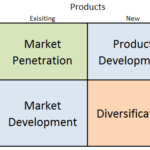 Marriott Ansoff Matrix is a marketing planning model that helps the international hotel chain to determine its product and market strategy. Ansoff Matrix illustrates four different strategy options available for businesses. These are market penetration, product development, market development and diversification. Marriott Ansoff Growth Matrix Within the scope of Ansoff Matrix, Marriott International uses all four growth strategies in an integrated manner: 1. Market penetration. Market penetration refers to selling existing products and services to existing markets in increased quantities. Market penetration is one of the main growth strategies for Marriott. The company uses this strategy through competitive pricing for some of the brands within its portfolio, promotional discounts, targeted marketing and other means. Moreover, Marriott Bonvoy loyalty program plays in instrumental role in increasing the effectiveness of market penetration. 2. Product development. This growth strategy involves developing new products to sell to existing markets. Marriott has a strong track record of developing and launching new brands and hotel concepts that meet the evolving needs of its customers. For example, the company launched several new brands in recent years, such as Moxy Hotels, AC Hotels by Marriott, and Autograph Collection, as well as, new hotel concepts such as Tribute Portfolio and Element Hotels. 3. Market development. Market development strategy is associated with finding new markets for existing products. An extensive focus on market development business strategy has allowed Marriott International to become the largest hotel chain in the world operating in 138 countries and territories under 30 brand names.[1] 4. Diversification. Diversification involves developing new products to sell to new markets and this is considered to be the riskiest strategy. Marriott uses diversification sparingly, preferring to stick to its core hotel business. The rare cases of diversification for the hotel chain include entering into vacation rentals, timeshares and operating…
Marriott Ansoff Matrix is a marketing planning model that helps the international hotel chain to determine its product and market strategy. Ansoff Matrix illustrates four different strategy options available for businesses. These are market penetration, product development, market development and diversification. Marriott Ansoff Growth Matrix Within the scope of Ansoff Matrix, Marriott International uses all four growth strategies in an integrated manner: 1. Market penetration. Market penetration refers to selling existing products and services to existing markets in increased quantities. Market penetration is one of the main growth strategies for Marriott. The company uses this strategy through competitive pricing for some of the brands within its portfolio, promotional discounts, targeted marketing and other means. Moreover, Marriott Bonvoy loyalty program plays in instrumental role in increasing the effectiveness of market penetration. 2. Product development. This growth strategy involves developing new products to sell to existing markets. Marriott has a strong track record of developing and launching new brands and hotel concepts that meet the evolving needs of its customers. For example, the company launched several new brands in recent years, such as Moxy Hotels, AC Hotels by Marriott, and Autograph Collection, as well as, new hotel concepts such as Tribute Portfolio and Element Hotels. 3. Market development. Market development strategy is associated with finding new markets for existing products. An extensive focus on market development business strategy has allowed Marriott International to become the largest hotel chain in the world operating in 138 countries and territories under 30 brand names.[1] 4. Diversification. Diversification involves developing new products to sell to new markets and this is considered to be the riskiest strategy. Marriott uses diversification sparingly, preferring to stick to its core hotel business. The rare cases of diversification for the hotel chain include entering into vacation rentals, timeshares and operating…Sunday, October 22, 2023
Marriott Leadership: an overview
 The current CEO of Marriott International is Anthony Capuano. He has been with the company for over 25 years and has held a variety of leadership positions, including Chief Development Officer and President of Global Development. Capuano is known for his strategic thinking and his ability to build and lead high-performing teams. Marriott International‘s leadership team is also notable for its diversity. The company’s executive team includes women, people of colour, and representatives from all over the world. This diversity of experience and perspectives helps Marriott International to better understand its customers and to develop innovative products and services. In terms of leadership style, Marriott is known for its commitment to servant leadership. Servant leaders focus on serving their employees and customers, rather than the other way around. This approach has helped Marriott International to create a positive work culture and to build strong customer relationships. Marriott International has a leadership development program called Voyage. Voyage is a 12-18 month program that is available to recent university graduates and provides a combination of practical hands-on experience and leadership training. Participants in the Voyage program rotate through different departments within a Marriott hotel and receive training from experienced leaders. Upon successful completion of the program, participants are well-positioned for leadership roles within hotel chain. Furthermore, Marriott leadership practices integrate the following important elements: Focus on employee development. The largest hotel chain in the world invests heavily in employee development and training. The company believes that its employees are its most valuable asset, and it is committed to helping them succeed. Fostering the culture of innovation. Marriott encourages its employees to be innovative and to come up with new ideas. The company has a number of programs in place to support innovation, such as its “TakeCare” program, which allows employees to submit ideas for improving the company.…
The current CEO of Marriott International is Anthony Capuano. He has been with the company for over 25 years and has held a variety of leadership positions, including Chief Development Officer and President of Global Development. Capuano is known for his strategic thinking and his ability to build and lead high-performing teams. Marriott International‘s leadership team is also notable for its diversity. The company’s executive team includes women, people of colour, and representatives from all over the world. This diversity of experience and perspectives helps Marriott International to better understand its customers and to develop innovative products and services. In terms of leadership style, Marriott is known for its commitment to servant leadership. Servant leaders focus on serving their employees and customers, rather than the other way around. This approach has helped Marriott International to create a positive work culture and to build strong customer relationships. Marriott International has a leadership development program called Voyage. Voyage is a 12-18 month program that is available to recent university graduates and provides a combination of practical hands-on experience and leadership training. Participants in the Voyage program rotate through different departments within a Marriott hotel and receive training from experienced leaders. Upon successful completion of the program, participants are well-positioned for leadership roles within hotel chain. Furthermore, Marriott leadership practices integrate the following important elements: Focus on employee development. The largest hotel chain in the world invests heavily in employee development and training. The company believes that its employees are its most valuable asset, and it is committed to helping them succeed. Fostering the culture of innovation. Marriott encourages its employees to be innovative and to come up with new ideas. The company has a number of programs in place to support innovation, such as its “TakeCare” program, which allows employees to submit ideas for improving the company.…Saturday, October 21, 2023
A Brief Overview of Marriott Business Strategy
 Marriott business strategy consists of the following 3 elements: 1. Pursuing asset-light business model. Operating in light-asset manner is one of the cornerstones of Marriott business strategy. Under this model, Marriott focuses on managing and franchising hotels, rather than owning them. This allows the hotel chain to expand rapidly and efficiently, without having to invest heavily in real estate. Light-assed strategy provides the company with a range of substantial advantages such as reduced capital investment and as a result, increased flexibility to enter into new markets and experiment with new brands. Furthermore, this strategy reduces exposure to the risk of real estate market downturns. 2. Growth through acquisitions. Marriott International has been a major user of acquisitions to fuel its growth. In 2016, it acquired Starwood Hotels & Resorts Worldwide in an USD 13.6 billion deal, which made it the world’s largest hotel company. The acquisition added nearly 1,300 hotels to Marriott’s portfolio, including brands such as Sheraton, W, and Westin. Since the Starwood acquisition, Marriott has continued to make smaller acquisitions to expand its reach into new markets and segments. For example, in 2017, it acquired Delta Hotels and Resorts, which added 38 hotels in Canada to its portfolio. In 2022, it acquired Hoteles City Express, which added 152 hotels in Mexico, Costa Rica, Colombia, and Chile. 3. Focusing on bleisure travellers. Bleisure travelling, a portmanteau of “business” and “leisure”, refers to the trend of business travellers extending their trips to include leisure activities. Marriott International is increasing its focus on bleisure travellers as part of its long-term business strategy. Up to date, this new customer segment, the business traveller who wants more choices for accommodations, that new blended traveller, and younger travellers who want more space for their travels, have been mainly served by Airbnb and…
Marriott business strategy consists of the following 3 elements: 1. Pursuing asset-light business model. Operating in light-asset manner is one of the cornerstones of Marriott business strategy. Under this model, Marriott focuses on managing and franchising hotels, rather than owning them. This allows the hotel chain to expand rapidly and efficiently, without having to invest heavily in real estate. Light-assed strategy provides the company with a range of substantial advantages such as reduced capital investment and as a result, increased flexibility to enter into new markets and experiment with new brands. Furthermore, this strategy reduces exposure to the risk of real estate market downturns. 2. Growth through acquisitions. Marriott International has been a major user of acquisitions to fuel its growth. In 2016, it acquired Starwood Hotels & Resorts Worldwide in an USD 13.6 billion deal, which made it the world’s largest hotel company. The acquisition added nearly 1,300 hotels to Marriott’s portfolio, including brands such as Sheraton, W, and Westin. Since the Starwood acquisition, Marriott has continued to make smaller acquisitions to expand its reach into new markets and segments. For example, in 2017, it acquired Delta Hotels and Resorts, which added 38 hotels in Canada to its portfolio. In 2022, it acquired Hoteles City Express, which added 152 hotels in Mexico, Costa Rica, Colombia, and Chile. 3. Focusing on bleisure travellers. Bleisure travelling, a portmanteau of “business” and “leisure”, refers to the trend of business travellers extending their trips to include leisure activities. Marriott International is increasing its focus on bleisure travellers as part of its long-term business strategy. Up to date, this new customer segment, the business traveller who wants more choices for accommodations, that new blended traveller, and younger travellers who want more space for their travels, have been mainly served by Airbnb and…Marriott International Inc. Report
 Marriott International is a worldwide operator, franchisor, and licensor of hotel, residential, timeshare, and other lodging properties in 138 countries and territories under 30 brand names. Started as a root beer stand in 1927 in Washington D.C., USA, Marriott has grown into the largest hotel chain in the world. For the full year 2022, gross fee revenues totalled USD 4.1 billion, a significant increase of more than 50 percent compared to 2021. Adjusted EBITDA reached nearly USD 3.9 billion in 2022, up almost 70 percent year over year. Full year adjusted diluted earnings per share (EPS) more than doubled from 2021, totalling USD 6.69. In 2022, Marriott International grew from 7,989 properties (1,479,179 rooms) at year-end 2021 to 8,288 properties (1,525,407 rooms) at year-end 2022, reflecting gross additions of 394 properties (65,376 rooms) and deletions of 94 properties (19,079 rooms), including the impact of the Company’s decision to suspend its operations in Russia. Marriott business strategy integrates pursuing asset-light business model and growing through acquisitions. Moreover, the largest hotel chain in the world focuses on increasing customer segment known as “bleisure travellers”. CEO Anthony Capuano and senior management pursue servant leadership style and the hotel chain has a hybrid organizational structure that combining elements of matrix and functional structures. Marriott International Inc. Report contains the application of the major analytical strategic frameworks in business studies such as SWOT, PESTEL, Porter’s Five Forces, Value Chain analysis, Ansoff Matrix and McKinsey 7S Model on Marriott. Moreover, the report contains analyses of Marriott’s business strategy, leadership and organizational structure and ecosystem. The report also analysis marketing strategy, ecosystem and discusses the issues of corporate social responsibility. 1. Executive Summary 2. Business Strategy 3. Marriott Stock Performance Analysis 4. Leadership 5. Organisational Structure 6. Organizational Culture 7. Marriott and Ansoff Matrix 8. SWOT Analysis…
Marriott International is a worldwide operator, franchisor, and licensor of hotel, residential, timeshare, and other lodging properties in 138 countries and territories under 30 brand names. Started as a root beer stand in 1927 in Washington D.C., USA, Marriott has grown into the largest hotel chain in the world. For the full year 2022, gross fee revenues totalled USD 4.1 billion, a significant increase of more than 50 percent compared to 2021. Adjusted EBITDA reached nearly USD 3.9 billion in 2022, up almost 70 percent year over year. Full year adjusted diluted earnings per share (EPS) more than doubled from 2021, totalling USD 6.69. In 2022, Marriott International grew from 7,989 properties (1,479,179 rooms) at year-end 2021 to 8,288 properties (1,525,407 rooms) at year-end 2022, reflecting gross additions of 394 properties (65,376 rooms) and deletions of 94 properties (19,079 rooms), including the impact of the Company’s decision to suspend its operations in Russia. Marriott business strategy integrates pursuing asset-light business model and growing through acquisitions. Moreover, the largest hotel chain in the world focuses on increasing customer segment known as “bleisure travellers”. CEO Anthony Capuano and senior management pursue servant leadership style and the hotel chain has a hybrid organizational structure that combining elements of matrix and functional structures. Marriott International Inc. Report contains the application of the major analytical strategic frameworks in business studies such as SWOT, PESTEL, Porter’s Five Forces, Value Chain analysis, Ansoff Matrix and McKinsey 7S Model on Marriott. Moreover, the report contains analyses of Marriott’s business strategy, leadership and organizational structure and ecosystem. The report also analysis marketing strategy, ecosystem and discusses the issues of corporate social responsibility. 1. Executive Summary 2. Business Strategy 3. Marriott Stock Performance Analysis 4. Leadership 5. Organisational Structure 6. Organizational Culture 7. Marriott and Ansoff Matrix 8. SWOT Analysis…Friday, September 22, 2023
Netflix CSR Overview
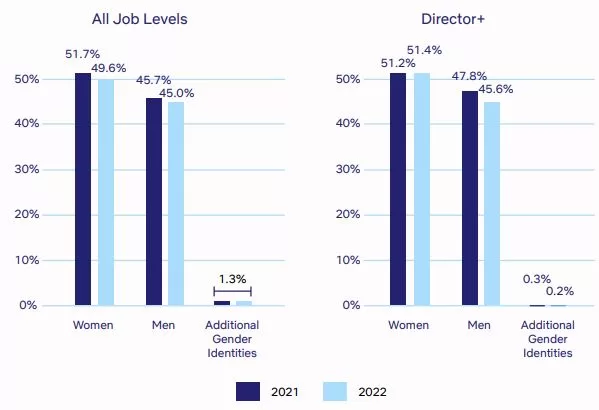 Netflix CSR Programs and Initiatives Netflix Supporting Local Communities The entertainment services provider maintains employee giving program that provides a 2:1 match on employee donations. As part of the program the company and employees donated USD34 million to over 5,000 charities worldwide Netflix and Gender Equality and Minorities 49,6% of Netflix employees are women 50% of US workforce are from historically excluded ethnic and/or racial backgrounds Netflix Fund for Creative Equity helps to create opportunities within the entertainment industry for minorities and historically under-represented groups Figure 1 Global Gender Identities at Netflix for 2022 Energy Consumption by Netflix In 2022 the company completed energy efficiency audits at its major facilities across North America The entertainment services provider uses 100% renewable electricity in all offices and productions it directly manages Carbon Emissions by Netflix Netflix is committed to reduce carbon emission by 50% by 2030 compared to 2019 baseline The entertainment services provider uses clean technology on over 60% of productions it manages directly In 2022 about 50% of the productions Netflix managed incorporated clean mobile power solutions such as grid tie-ins, mobile batteries, battery-hybrid generators, and hydrogen power units, resulting in fuel reductions that lowered emissions by 1,179 MTCO2e The company uses at least one electric vehicle (EV) on screen on all of its directly-managed productions The streaming service supports creators who choose to incorporate sustainability into their storytelling Figure 2 Netflix carbon footpring by business activity in 2022 Netflix and Sustainable Sourcing The company spent about USD 700 million with underrepresented suppliers in 2022 Governance Practices Netflix is beginning a phased declassification of its board in 2023. Starting from 2025 each board member will stand for annual elections The company is eliminating supermajority voting provisions in its articles of incorporation and bylaws The streaming…
Netflix CSR Programs and Initiatives Netflix Supporting Local Communities The entertainment services provider maintains employee giving program that provides a 2:1 match on employee donations. As part of the program the company and employees donated USD34 million to over 5,000 charities worldwide Netflix and Gender Equality and Minorities 49,6% of Netflix employees are women 50% of US workforce are from historically excluded ethnic and/or racial backgrounds Netflix Fund for Creative Equity helps to create opportunities within the entertainment industry for minorities and historically under-represented groups Figure 1 Global Gender Identities at Netflix for 2022 Energy Consumption by Netflix In 2022 the company completed energy efficiency audits at its major facilities across North America The entertainment services provider uses 100% renewable electricity in all offices and productions it directly manages Carbon Emissions by Netflix Netflix is committed to reduce carbon emission by 50% by 2030 compared to 2019 baseline The entertainment services provider uses clean technology on over 60% of productions it manages directly In 2022 about 50% of the productions Netflix managed incorporated clean mobile power solutions such as grid tie-ins, mobile batteries, battery-hybrid generators, and hydrogen power units, resulting in fuel reductions that lowered emissions by 1,179 MTCO2e The company uses at least one electric vehicle (EV) on screen on all of its directly-managed productions The streaming service supports creators who choose to incorporate sustainability into their storytelling Figure 2 Netflix carbon footpring by business activity in 2022 Netflix and Sustainable Sourcing The company spent about USD 700 million with underrepresented suppliers in 2022 Governance Practices Netflix is beginning a phased declassification of its board in 2023. Starting from 2025 each board member will stand for annual elections The company is eliminating supermajority voting provisions in its articles of incorporation and bylaws The streaming…Netflix Ecosystem: an overview
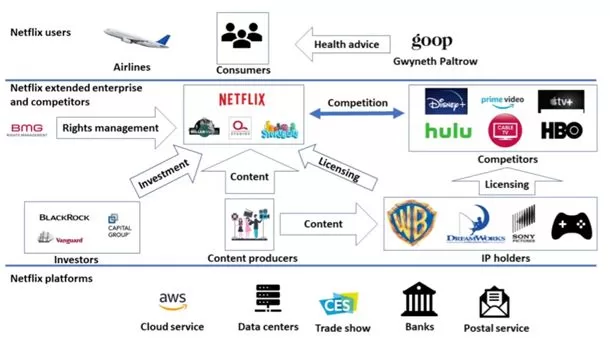 An ecosystem is a network of components (products, services and platforms) that depend on each other and fuel each other to jointly deliver greater value. Netflix ecosystem comprises the companies it owns, content producers, competitors, customers, as well as, investors. Moreover, assisting infrastructure such as AWS cloud service, data centres, trade shows, banks and postal service are also components of Netflix ecosystem. All of the entities listed above are considered elements of ecosystem, because they contribute to the survival and well-being of the ecosystem. Netflix ecosystem Development of business ecosystem can be divided into four stages[1]: 1. Pioneering stage is where ecosystem is formed. For video streaming ecosystem pioneering stage is the second half of 2000s. Netflix invented DVD rental business model and it is one of the first companies that offered online video streaming service. Hong Kong based iTV was the company that introduced online video streaming for the first time, but Netflix was the first company that perfected this business model and made it successful. 2. Expansion stage. Currently, Netflix has 231 million paid memberships in over 190 countries with offices in over 25 countries.[2] The rapid expansion of the company during the last decade caused the expansion of online streaming ecosystem in general, motivating media companies to launch their own rival streaming services such as Disney+, HBO, Hulu and others. 3. Authority stage is when an ecosystem matures. It can be argued that Netflix ecosystem is approaching its authority stage with the global marketplace becoming highly saturated with international, as well as, local on-demand media providers. The video entertainment industry is becoming ready for yet another disruption. 4. Renewal or death stage. It is hard to estimate the time when Netflix ecosystem is going to be renewed or if it is going to cease to exist altogether…
An ecosystem is a network of components (products, services and platforms) that depend on each other and fuel each other to jointly deliver greater value. Netflix ecosystem comprises the companies it owns, content producers, competitors, customers, as well as, investors. Moreover, assisting infrastructure such as AWS cloud service, data centres, trade shows, banks and postal service are also components of Netflix ecosystem. All of the entities listed above are considered elements of ecosystem, because they contribute to the survival and well-being of the ecosystem. Netflix ecosystem Development of business ecosystem can be divided into four stages[1]: 1. Pioneering stage is where ecosystem is formed. For video streaming ecosystem pioneering stage is the second half of 2000s. Netflix invented DVD rental business model and it is one of the first companies that offered online video streaming service. Hong Kong based iTV was the company that introduced online video streaming for the first time, but Netflix was the first company that perfected this business model and made it successful. 2. Expansion stage. Currently, Netflix has 231 million paid memberships in over 190 countries with offices in over 25 countries.[2] The rapid expansion of the company during the last decade caused the expansion of online streaming ecosystem in general, motivating media companies to launch their own rival streaming services such as Disney+, HBO, Hulu and others. 3. Authority stage is when an ecosystem matures. It can be argued that Netflix ecosystem is approaching its authority stage with the global marketplace becoming highly saturated with international, as well as, local on-demand media providers. The video entertainment industry is becoming ready for yet another disruption. 4. Renewal or death stage. It is hard to estimate the time when Netflix ecosystem is going to be renewed or if it is going to cease to exist altogether…Netflix McKinsey 7S Model
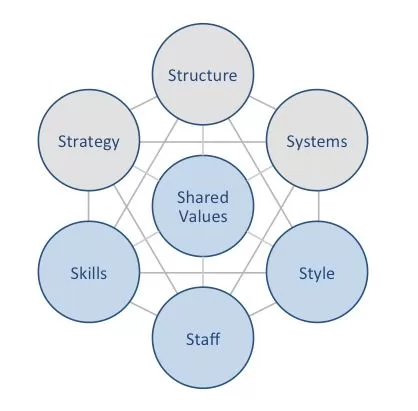 Netflix McKinsey 7S model shows how seven elements of businesses can be aligned to increase the overall effectiveness. According to the framework strategy, structure and systems are hard elements, while shared values, skills, style and staff represent soft elements. McKinsey 7S model stresses the presence of strong links between elements in a way that a change in one element causes changes in others. As it is illustrated in Figure 6 below, shared values are placed at the core of Netflix McKinsey 7S model. This is because shared values guide employee behaviour with implications on their performance. McKinsey 7S model Hard Elements in Netflix McKinsey 7S Model Strategy Nvidia business strategy relies on focusing on revenues maximization over membership growth and investing in original content. The entertainment services provider considers its globally successful original content such as House of Cards (2013-2018), BoJack Horseman (2020) and Squid Game (2021) as its unique selling proposition amid intensifying competition. Moreover, the largest streaming service in the world stays away from news and live sports segments, sticking to movies, series, documentaries and games, as part of its business strategy. Structure Netflix organizational structure is flat and unitary. There are considerably less management layers considering the size of the company and scope of its operations comprising 12500 people in offices in over 25 countries.[1] As a result, the flow of information is fast at the on-demand media provider and this contributes to the flexibility of the business to external macroeconomic changes. Systems There is a wide range of systems and processes that are important for the largest streaming service in the world to sustain its business. These systems include employee recruitment and selection, team development and orientation, transaction processing, customer relationship management, business intelligence, knowledge management and others. Furthermore, the system of…
Netflix McKinsey 7S model shows how seven elements of businesses can be aligned to increase the overall effectiveness. According to the framework strategy, structure and systems are hard elements, while shared values, skills, style and staff represent soft elements. McKinsey 7S model stresses the presence of strong links between elements in a way that a change in one element causes changes in others. As it is illustrated in Figure 6 below, shared values are placed at the core of Netflix McKinsey 7S model. This is because shared values guide employee behaviour with implications on their performance. McKinsey 7S model Hard Elements in Netflix McKinsey 7S Model Strategy Nvidia business strategy relies on focusing on revenues maximization over membership growth and investing in original content. The entertainment services provider considers its globally successful original content such as House of Cards (2013-2018), BoJack Horseman (2020) and Squid Game (2021) as its unique selling proposition amid intensifying competition. Moreover, the largest streaming service in the world stays away from news and live sports segments, sticking to movies, series, documentaries and games, as part of its business strategy. Structure Netflix organizational structure is flat and unitary. There are considerably less management layers considering the size of the company and scope of its operations comprising 12500 people in offices in over 25 countries.[1] As a result, the flow of information is fast at the on-demand media provider and this contributes to the flexibility of the business to external macroeconomic changes. Systems There is a wide range of systems and processes that are important for the largest streaming service in the world to sustain its business. These systems include employee recruitment and selection, team development and orientation, transaction processing, customer relationship management, business intelligence, knowledge management and others. Furthermore, the system of…Wednesday, September 20, 2023
Netflix Value Chain Analysis
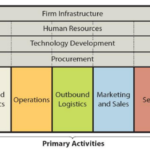 Value chain analysis is an analytical tool that can be used to find business activities that can create value and competitive advantage to the on-demand media provider. Figure below illustrates the essence of Netflix value chain analysis. Netflix Value Chain Analysis Netflix Primary Activities Netflix Inbound logistics Inbound logistics involves the processes associated with receiving and storing raw materials to create output. For a streaming service such as Netflix content is the raw material. Establishing strategic relationship with content producers and intellectual property holders such as Warner Brothers, Dream Works and Sony Pictures are the main sources of inbound logistics value creation for a streaming business. Netflix is utilizing these sources extensively. Currently, Netflix is increasing investments to produce its own, original content such as Squid Game, BoJack Horseman and Stranger Things as a differentiator amid intensifying competition. This shift has certain implications on inbound logistics aspect of the business. Specifically, focus on original content requires greater involvement in inbound logistics for the largest streaming service in the world. Netflix Operations Operations are the stage where inbound logistics are transformed into outbound logistics. For Netflix, operational efficiency and cost advantage are the main sources of value creation at this stage. The on-demand media provider has to maintain its video streaming platform effectively in terms of ease of access, quick search, stability, and security of the server. Netflix Outbound Logistics Outbound logistics refer to the distribution of products and services to customers. Usual sources of value creation in outbound logistics include Delivering to consumers directly without intermediaries, Cooperation with other businesses to share distribution costs and extensive integration of information and communication technologies. Considering that Netflix delivers digital media through streaming and downloads, the relevance of outbound logistics aspect of value chain analysis for the largest streaming service in…
Value chain analysis is an analytical tool that can be used to find business activities that can create value and competitive advantage to the on-demand media provider. Figure below illustrates the essence of Netflix value chain analysis. Netflix Value Chain Analysis Netflix Primary Activities Netflix Inbound logistics Inbound logistics involves the processes associated with receiving and storing raw materials to create output. For a streaming service such as Netflix content is the raw material. Establishing strategic relationship with content producers and intellectual property holders such as Warner Brothers, Dream Works and Sony Pictures are the main sources of inbound logistics value creation for a streaming business. Netflix is utilizing these sources extensively. Currently, Netflix is increasing investments to produce its own, original content such as Squid Game, BoJack Horseman and Stranger Things as a differentiator amid intensifying competition. This shift has certain implications on inbound logistics aspect of the business. Specifically, focus on original content requires greater involvement in inbound logistics for the largest streaming service in the world. Netflix Operations Operations are the stage where inbound logistics are transformed into outbound logistics. For Netflix, operational efficiency and cost advantage are the main sources of value creation at this stage. The on-demand media provider has to maintain its video streaming platform effectively in terms of ease of access, quick search, stability, and security of the server. Netflix Outbound Logistics Outbound logistics refer to the distribution of products and services to customers. Usual sources of value creation in outbound logistics include Delivering to consumers directly without intermediaries, Cooperation with other businesses to share distribution costs and extensive integration of information and communication technologies. Considering that Netflix delivers digital media through streaming and downloads, the relevance of outbound logistics aspect of value chain analysis for the largest streaming service in…Netflix Porter’s Five Forces Analysis
 Porter’s Five Forces analytical framework developed by Michael Porter (1979)[1] represents five individual forces that shape an overall extent of competition in the industry. These forces are illustrated in Figure 1 below: Figure 1. Porter’s Five Forces Threat of new entrants in Netflix Porter’s Five Forces Threat of new entrants into the on-demand media streaming is low. Setting up a video steaming website is not difficult from a technical point of view. However, adding an adequate amount of content with the permission of copyright holders and gaining market share is highly difficult. The following are the most noteworthy challenges for new market entrants. Market saturation The market of on-demand media streaming is highly saturated with the streaming giants such as Netflix, Amazon Prime Video, Disney+, Hulu, Apple TV+, HBO Max and others dominating the global market. The majority of representatives of the target customer segment i.e. people with phones, tablets or TVs with internet connection are already subscribed to one or more of the leading streaming services mentioned above. It will be challenging for new market entrants to attract enough subscribers to make a break-even in this sector High entry costs Major market players such as Netflix focus on original content in general and its quality in particular to differentiate themselves in the market. As illustrated in Figure 4 below, the titles of original content produced by the largest streaming service in the world, as well as the hours watched by its customers have been consistently increasing for the past 10 years with the exception of a decline in 2021. Figure 2 Netflix original content by years of transmission[2] Netflix original content spending exceeded USD 5,8 billion in 2022[3] and its main competitors also spend billions of dollars annually for creating new films and programs. Accordingly, the…
Porter’s Five Forces analytical framework developed by Michael Porter (1979)[1] represents five individual forces that shape an overall extent of competition in the industry. These forces are illustrated in Figure 1 below: Figure 1. Porter’s Five Forces Threat of new entrants in Netflix Porter’s Five Forces Threat of new entrants into the on-demand media streaming is low. Setting up a video steaming website is not difficult from a technical point of view. However, adding an adequate amount of content with the permission of copyright holders and gaining market share is highly difficult. The following are the most noteworthy challenges for new market entrants. Market saturation The market of on-demand media streaming is highly saturated with the streaming giants such as Netflix, Amazon Prime Video, Disney+, Hulu, Apple TV+, HBO Max and others dominating the global market. The majority of representatives of the target customer segment i.e. people with phones, tablets or TVs with internet connection are already subscribed to one or more of the leading streaming services mentioned above. It will be challenging for new market entrants to attract enough subscribers to make a break-even in this sector High entry costs Major market players such as Netflix focus on original content in general and its quality in particular to differentiate themselves in the market. As illustrated in Figure 4 below, the titles of original content produced by the largest streaming service in the world, as well as the hours watched by its customers have been consistently increasing for the past 10 years with the exception of a decline in 2021. Figure 2 Netflix original content by years of transmission[2] Netflix original content spending exceeded USD 5,8 billion in 2022[3] and its main competitors also spend billions of dollars annually for creating new films and programs. Accordingly, the…Netflix Marketing Communication Mix
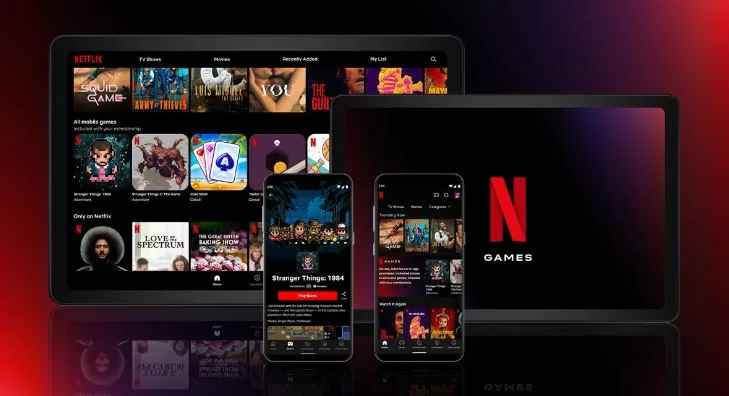 Netflix marketing communication mix comprises communication channels to communicate the marketing message to the target customer segment. These channels are print and media advertising, sales promotions, events and experiences, public relations and direct marketing. Netflix Print and Media Advertising Netflix uses print and media advertising extensively as one of the main pillars of its marketing strategy. Specifically, the streaming service uses TV, radio, magazines, newspapers, as well as, billboards and posters to spread its marketing message. Netflix print and media ads are usually captivating and some of them are widely discussed in the media in general and social media in particular expanding the brand coverage with no extra cost for the streaming service. For example, to promote its Altered Carbon series in 2018, the streaming service placed a naked mannequin that appeared to be breathing at the bus stop on Santa Monica Boulevard in Crescent Heights in West Hollywood. The on-demand media provider also benefits from celebrity endorsement in terms of increasing the level of brand awareness internationally. The most famous Netflix endorses include Barack Obama and Michelle Obama, Ryan Reynolds, Jennifer Aniston, Reese Witherspoon, Shonda Rhimes and others. Netflix Sales Promotions Netflix uses the following sales promotion techniques: – Money off coupons. The entertainment services provider partners with a variety of companies to provide special promotional offers. Customers can redeem promo codes on Netflix website and start using its services for a specific period of time – Seasonal sales promotions. The streaming service regularly offers promotions on festive seasons and holidays such as Black Friday, Cyber Monday, Valentine’s Day, Mother’s Day and Father’s Day. Netflix Inc. Report contains a full analysis of Netflix marketing communication mix and Netflix marketing strategy in general. The report illustrates the application of the major analytical strategic frameworks in business studies such as SWOT,…
Netflix marketing communication mix comprises communication channels to communicate the marketing message to the target customer segment. These channels are print and media advertising, sales promotions, events and experiences, public relations and direct marketing. Netflix Print and Media Advertising Netflix uses print and media advertising extensively as one of the main pillars of its marketing strategy. Specifically, the streaming service uses TV, radio, magazines, newspapers, as well as, billboards and posters to spread its marketing message. Netflix print and media ads are usually captivating and some of them are widely discussed in the media in general and social media in particular expanding the brand coverage with no extra cost for the streaming service. For example, to promote its Altered Carbon series in 2018, the streaming service placed a naked mannequin that appeared to be breathing at the bus stop on Santa Monica Boulevard in Crescent Heights in West Hollywood. The on-demand media provider also benefits from celebrity endorsement in terms of increasing the level of brand awareness internationally. The most famous Netflix endorses include Barack Obama and Michelle Obama, Ryan Reynolds, Jennifer Aniston, Reese Witherspoon, Shonda Rhimes and others. Netflix Sales Promotions Netflix uses the following sales promotion techniques: – Money off coupons. The entertainment services provider partners with a variety of companies to provide special promotional offers. Customers can redeem promo codes on Netflix website and start using its services for a specific period of time – Seasonal sales promotions. The streaming service regularly offers promotions on festive seasons and holidays such as Black Friday, Cyber Monday, Valentine’s Day, Mother’s Day and Father’s Day. Netflix Inc. Report contains a full analysis of Netflix marketing communication mix and Netflix marketing strategy in general. The report illustrates the application of the major analytical strategic frameworks in business studies such as SWOT,…Tuesday, September 19, 2023
Netflix Marketing Mix (Netflix 7Ps of Marketing)
 Netflix marketing mix (Netflix 7Ps of marketing) comprises elements of the marketing mix. These elements are product, place, price, promotion, process, people and physical evidence. Product Element in Netflix Marketing Mix (Netflix 7Ps of Marketing) Netflix produces TV series, films and games across a wide variety of genres and languages. These are referred to as content. Netflix content can be divided into three categories: Licensed non-first window content. Licensed original first-window content Owned original first-window content. Place Element in Netflix Marketing Mix (Netflix 7Ps of Marketing) Netflix has offices in over 25 countries. The entertainment services provider creates films and series in more than 50 countries. Except for Albuquerque Studios in New Mexico and the Egyptian Theater in Los Angeles, Netflix does not own the facilities in which it operates. As of December 31, 2022, the streaming service had approximately 12,800 full-time employees located globally in 65 countries. Netflix is available virtually everywhere except in China and Russia and it has 231 million paid memberships in over 190 countries. [1] Price Element in Netflix Marketing Mix (Netflix 7Ps of Marketing) Netflix pricing strategy integrates the following elements: Value pricing. The entertainment services provider employs value pricing strategy. The company determines subscription cost for its streaming service on the basis of their perceived value by customers. Moreover, the on-demand media provider closely monitors the prices of its major competitors such as HBO Max, Hulu, Amazon Prime Video, Disney+ and Apple TV+ and adjusts its prices accordingly. Geographic pricing. Netflix prices vary in over 190 countries it operates to reflect local consumer purchasing power, competition and a range of other factors. For example, As of July 2023 the Premium package with streaming quality 4K Ultra HD and HDR costs USD 19,99 in USA and R199 (USD 11,16) in South…
Netflix marketing mix (Netflix 7Ps of marketing) comprises elements of the marketing mix. These elements are product, place, price, promotion, process, people and physical evidence. Product Element in Netflix Marketing Mix (Netflix 7Ps of Marketing) Netflix produces TV series, films and games across a wide variety of genres and languages. These are referred to as content. Netflix content can be divided into three categories: Licensed non-first window content. Licensed original first-window content Owned original first-window content. Place Element in Netflix Marketing Mix (Netflix 7Ps of Marketing) Netflix has offices in over 25 countries. The entertainment services provider creates films and series in more than 50 countries. Except for Albuquerque Studios in New Mexico and the Egyptian Theater in Los Angeles, Netflix does not own the facilities in which it operates. As of December 31, 2022, the streaming service had approximately 12,800 full-time employees located globally in 65 countries. Netflix is available virtually everywhere except in China and Russia and it has 231 million paid memberships in over 190 countries. [1] Price Element in Netflix Marketing Mix (Netflix 7Ps of Marketing) Netflix pricing strategy integrates the following elements: Value pricing. The entertainment services provider employs value pricing strategy. The company determines subscription cost for its streaming service on the basis of their perceived value by customers. Moreover, the on-demand media provider closely monitors the prices of its major competitors such as HBO Max, Hulu, Amazon Prime Video, Disney+ and Apple TV+ and adjusts its prices accordingly. Geographic pricing. Netflix prices vary in over 190 countries it operates to reflect local consumer purchasing power, competition and a range of other factors. For example, As of July 2023 the Premium package with streaming quality 4K Ultra HD and HDR costs USD 19,99 in USA and R199 (USD 11,16) in South…Monday, September 18, 2023
Netflix Marketing Strategy: an overview
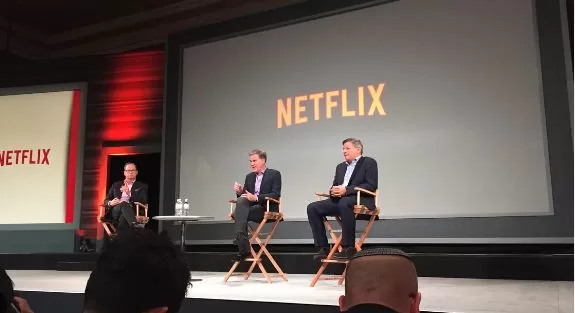 Netflix marketing strategy assists in achieving company’s corporate mission of seeking to drive conversation around Netflix content to further enhance member joy. In 2022 The streaming service spent in total to USD 2,53 billion or 8% of total revenues for marketing.[1] Netflix marketing strategy is based on the following principles: – Guerrilla marketing. Guerrilla marketing refers to an advertisement strategy where a company uses unusual methods to draw attention of the public to the brand. The most notable cases of guerrilla marketing by the largest streaming service in the world include a hand crawling by itself in the streets of New York to promote Wednesday show, “Strange Mode” car sharing ride with Lyft and installing doll from Squid Game show in Sydney Harbour. – High level of service personalization. The entertainment services provider suggests personalized content to its users on the basis of the past viewed content. The on-demand media provider suggests personalized content in its platform, as well as, thorough emails to maintain the high level of customer retention. – Meme marketing. Netflix effectively uses social media marketing in general and meme marketing in particular to increase the level of brand awareness in the global scale. One can be forgiven for mistaking Netflix social media pages for pages for meme. – Remaining focused. Netflix only offers movies, series and documentaries. The platform does not offer news and live sports. By remaining focused on movies, series and documentaries alone, the company avoids overextension of brand image and continues to increase the value it provides to its core audience. Netflix Inc. Report contains the above analysis of Netflix marketing strategy. The report illustrates the application of the major analytical strategic frameworks in business studies such as SWOT, PESTEL, Porter’s Five Forces, Value Chain analysis, Ansoff Matrix and McKinsey 7S…
Netflix marketing strategy assists in achieving company’s corporate mission of seeking to drive conversation around Netflix content to further enhance member joy. In 2022 The streaming service spent in total to USD 2,53 billion or 8% of total revenues for marketing.[1] Netflix marketing strategy is based on the following principles: – Guerrilla marketing. Guerrilla marketing refers to an advertisement strategy where a company uses unusual methods to draw attention of the public to the brand. The most notable cases of guerrilla marketing by the largest streaming service in the world include a hand crawling by itself in the streets of New York to promote Wednesday show, “Strange Mode” car sharing ride with Lyft and installing doll from Squid Game show in Sydney Harbour. – High level of service personalization. The entertainment services provider suggests personalized content to its users on the basis of the past viewed content. The on-demand media provider suggests personalized content in its platform, as well as, thorough emails to maintain the high level of customer retention. – Meme marketing. Netflix effectively uses social media marketing in general and meme marketing in particular to increase the level of brand awareness in the global scale. One can be forgiven for mistaking Netflix social media pages for pages for meme. – Remaining focused. Netflix only offers movies, series and documentaries. The platform does not offer news and live sports. By remaining focused on movies, series and documentaries alone, the company avoids overextension of brand image and continues to increase the value it provides to its core audience. Netflix Inc. Report contains the above analysis of Netflix marketing strategy. The report illustrates the application of the major analytical strategic frameworks in business studies such as SWOT, PESTEL, Porter’s Five Forces, Value Chain analysis, Ansoff Matrix and McKinsey 7S…Netflix PESTEL Analysis
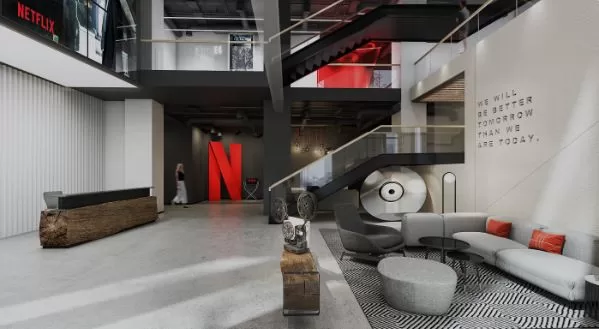 PESTEL is a strategic analytical tool and the acronym stands for political, economic, social, technological, environmental and legal factors. Netflix PESTEL analysis involves the analysis of potential impact of these factors on the bottom line and long-term growth prospects of the popular streaming platform. Political Factors in Netflix PESTEL Analysis There are many political factors that can affect the financial performance of on-demand streaming services such as Netflix. These factors include government stability, trade union activities, bureaucracy and government tariffs. Moreover, corruption, trade controls and the freedom of press also belong to the list of political factors with a potentially significant impact on entertainment services providers. Leaving a market because of war Netflix was indirectly affected by Vladimir Putin’s invasion of Ukraine. Having entered Russian market in 2016, the largest streaming service in the world announced on March 6, 2022 the suspension of its services, projects and acquisitions in the country. Leaving the country within 10 days after Putin declared war in Ukraine was an act of solidarity with Ukraine and other global brands suspending their operations in Russia. At the same time, Netflix had no other choice, because had the company remained in Russia its brand image would have suffered significantly with negative implications on the stock price. Government restrictions Apart from Russia, China is the only country where Netflix is not available. Although they dress it otherwise, the Chinese government has banned the popular streaming platform because they don’t want their citizens to be influenced by western culture. In other words, Chinese authorities fear that a wide range of shows and programs available on Netflix may influence the population and they might become more difficult to control. Taking into account the massive size of Chinese market, not being allowed to operate in the market is…
PESTEL is a strategic analytical tool and the acronym stands for political, economic, social, technological, environmental and legal factors. Netflix PESTEL analysis involves the analysis of potential impact of these factors on the bottom line and long-term growth prospects of the popular streaming platform. Political Factors in Netflix PESTEL Analysis There are many political factors that can affect the financial performance of on-demand streaming services such as Netflix. These factors include government stability, trade union activities, bureaucracy and government tariffs. Moreover, corruption, trade controls and the freedom of press also belong to the list of political factors with a potentially significant impact on entertainment services providers. Leaving a market because of war Netflix was indirectly affected by Vladimir Putin’s invasion of Ukraine. Having entered Russian market in 2016, the largest streaming service in the world announced on March 6, 2022 the suspension of its services, projects and acquisitions in the country. Leaving the country within 10 days after Putin declared war in Ukraine was an act of solidarity with Ukraine and other global brands suspending their operations in Russia. At the same time, Netflix had no other choice, because had the company remained in Russia its brand image would have suffered significantly with negative implications on the stock price. Government restrictions Apart from Russia, China is the only country where Netflix is not available. Although they dress it otherwise, the Chinese government has banned the popular streaming platform because they don’t want their citizens to be influenced by western culture. In other words, Chinese authorities fear that a wide range of shows and programs available on Netflix may influence the population and they might become more difficult to control. Taking into account the massive size of Chinese market, not being allowed to operate in the market is…Netflix SWOT Analysis
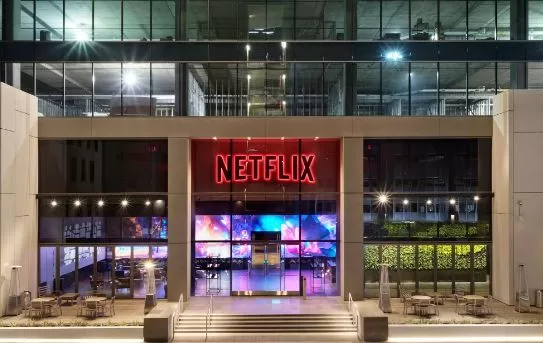 SWOT is an acronym for strengths, weaknesses, opportunities and threats for organizations of all types. The following table illustrates Netflix SWOT analysis: Strengths 1. First mover advantage 2. Corporate culture 3. Original content 4. Global presence Weaknesses 1. Dependence of business model on other companies 2. High level of indebtedness 3. Over-dependence on North American home market 4. Compromised customer service Opportunities 1. Forming strategic partnerships 2. Product line extension 3. Benefiting from AI 4. Increasing focus on locally adapted content Threats 1. Failure of new co-CEOs 2. Video piracy 3. Loss of customers due to rising prices 4. Global market saturation Netflix SWOT Analysis Strengths in Netflix SWOT Analysis 1. Although Netflix did not invent on-demand video streaming, it has proved that this business model can be viable. Netflix was the first company to scale video streaming globally and the company name has become synonym for subsection based on-demand media with huge content library. First mover advantage is a considerable strength for Netflix because it increases brand recognition considerably and establishes the company’s serves as industry standards. 2. Netflix is famous for its non-orthodox corporate culture. The entertainment services provider encourages decision-making by employees at all levels and shares information openly, broadly and deliberately. Moreover, internal communications at the largest streaming service in the world are candid and direct and this also relates to employee performance feedback. Sophisticated corporate culture established by co-founder and former long-term CEO Reed Hastings has played an integral role in the success of the company and it is one of the formidable strengths associated with the business. 3. Netflix was among the first streaming platforms to produce its own content starting from 2011. Over the years the entertainment services provider was able to produce critically acclaimed shows worldwide such as House…
SWOT is an acronym for strengths, weaknesses, opportunities and threats for organizations of all types. The following table illustrates Netflix SWOT analysis: Strengths 1. First mover advantage 2. Corporate culture 3. Original content 4. Global presence Weaknesses 1. Dependence of business model on other companies 2. High level of indebtedness 3. Over-dependence on North American home market 4. Compromised customer service Opportunities 1. Forming strategic partnerships 2. Product line extension 3. Benefiting from AI 4. Increasing focus on locally adapted content Threats 1. Failure of new co-CEOs 2. Video piracy 3. Loss of customers due to rising prices 4. Global market saturation Netflix SWOT Analysis Strengths in Netflix SWOT Analysis 1. Although Netflix did not invent on-demand video streaming, it has proved that this business model can be viable. Netflix was the first company to scale video streaming globally and the company name has become synonym for subsection based on-demand media with huge content library. First mover advantage is a considerable strength for Netflix because it increases brand recognition considerably and establishes the company’s serves as industry standards. 2. Netflix is famous for its non-orthodox corporate culture. The entertainment services provider encourages decision-making by employees at all levels and shares information openly, broadly and deliberately. Moreover, internal communications at the largest streaming service in the world are candid and direct and this also relates to employee performance feedback. Sophisticated corporate culture established by co-founder and former long-term CEO Reed Hastings has played an integral role in the success of the company and it is one of the formidable strengths associated with the business. 3. Netflix was among the first streaming platforms to produce its own content starting from 2011. Over the years the entertainment services provider was able to produce critically acclaimed shows worldwide such as House…Netflix Organizational Culture: an overview
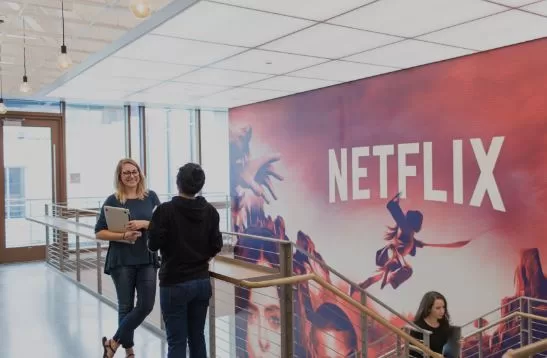 Netflix organizational culture integrates the following five key elements: 1. Encouraging decision-making by employees. The entertainment services provider encourages employees at all levels to take initiative and resolve issues on their own with minimum input from their superiors. Decision making at the on-demand media provider is made by individuals, referred to informed captains, rather than by teams or committees. Informed captains are experts in their area who listen to the viewpoints of other people and then make decisions on their own. Thanks to this principle Netflix doesn’t have to wait for consensus or vote by the committee and this is huge advantage taking into account highly dynamic nature of the external environment. 2. Sharing information openly, broadly and deliberately. Netflix has taken a radical approach towards information sharing. The largest streaming service in the world maintains online memos in narrative form for members of board of directors that not only include links to supporting analysis but also allow open access to all data and information on the company’s internal shared systems. This is unprecedented for a global corporation. Unlike, some other tech companies such as Apple, employees at all levels of the streaming service have access to all internal information. Access to data helps Netflix employees to make more informed decision making. Moreover, thanks to the access to information employees feel trusted and become more responsible at their job. 3. Communicating candidly and directly. Openness in communication is one of the pillars of Netflix organizational culture. Candid and direct communication also relates employee performance feedback. Openness has been ingrained into the culture of Netflix to such a degree that not speaking up one’s mind can be easily perceived as an act of disloyalty. 4. Keeping only our highly effective people. The streaming service models itself on being a…
Netflix organizational culture integrates the following five key elements: 1. Encouraging decision-making by employees. The entertainment services provider encourages employees at all levels to take initiative and resolve issues on their own with minimum input from their superiors. Decision making at the on-demand media provider is made by individuals, referred to informed captains, rather than by teams or committees. Informed captains are experts in their area who listen to the viewpoints of other people and then make decisions on their own. Thanks to this principle Netflix doesn’t have to wait for consensus or vote by the committee and this is huge advantage taking into account highly dynamic nature of the external environment. 2. Sharing information openly, broadly and deliberately. Netflix has taken a radical approach towards information sharing. The largest streaming service in the world maintains online memos in narrative form for members of board of directors that not only include links to supporting analysis but also allow open access to all data and information on the company’s internal shared systems. This is unprecedented for a global corporation. Unlike, some other tech companies such as Apple, employees at all levels of the streaming service have access to all internal information. Access to data helps Netflix employees to make more informed decision making. Moreover, thanks to the access to information employees feel trusted and become more responsible at their job. 3. Communicating candidly and directly. Openness in communication is one of the pillars of Netflix organizational culture. Candid and direct communication also relates employee performance feedback. Openness has been ingrained into the culture of Netflix to such a degree that not speaking up one’s mind can be easily perceived as an act of disloyalty. 4. Keeping only our highly effective people. The streaming service models itself on being a…Sunday, September 17, 2023
Netflix Organizational Structure: an overview
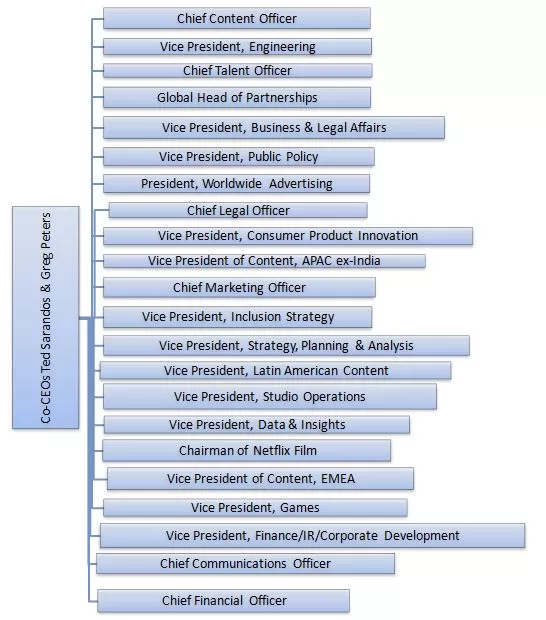 Netflix organizational structure can be classified as relatively flat. This is an unconventional for a multinational giant that employs more than 12500 people in offices in over 25 countries[1]. Fewer management layers increases the span of control for each manager. Corporate structure of Netflix can also be described as unitary or u-form. In companies with unitary structure the business is managed as a single unit and it has functional lines such as sales, marketing, engineering etc. Flat and unitary aspects of corporate culture of Netflix offers a range of advantages for the the entertainment services provider. Specifically, less hierarchy ensures faster and better communication among employees at all levels, thus increasing the speed and quality of decision making. This is critically important taking into account increasingly dynamic nature of the external marketplace and the need for the company to adapt quickly. Netflix organizational structure had to change early in 2023 when co-founder Reed Hastings stepped down from the role of CEO. Nevertheless, the flat and unitary nature of the organizational structure has remained. Moreover, even though Reed Hastings is no longer CEO of the on-demand media provider, he remains as the ultimate decision maker on the strategic issues. This arrangement may prove to be practically helpful whenever there is a disagreement between current co-CEOs Ted Sarandos and Greg Peters. Netflix Organizational Structure Netflix Inc. Report contains the above analysis of Netflix organizational structure. The report illustrates the application of the major analytical strategic frameworks in business studies such as SWOT, PESTEL, Porter’s Five Forces, Value Chain analysis, Ansoff Matrix and McKinsey 7S Model on Netflix. Moreover, the report contains analyses of Netflix leadership, business strategy and organizational culture. The report also comprises discussions of Netflix marketing strategy, ecosystem and addresses issues of corporate social responsibility. [1] ESG Report (2022)…
Netflix organizational structure can be classified as relatively flat. This is an unconventional for a multinational giant that employs more than 12500 people in offices in over 25 countries[1]. Fewer management layers increases the span of control for each manager. Corporate structure of Netflix can also be described as unitary or u-form. In companies with unitary structure the business is managed as a single unit and it has functional lines such as sales, marketing, engineering etc. Flat and unitary aspects of corporate culture of Netflix offers a range of advantages for the the entertainment services provider. Specifically, less hierarchy ensures faster and better communication among employees at all levels, thus increasing the speed and quality of decision making. This is critically important taking into account increasingly dynamic nature of the external marketplace and the need for the company to adapt quickly. Netflix organizational structure had to change early in 2023 when co-founder Reed Hastings stepped down from the role of CEO. Nevertheless, the flat and unitary nature of the organizational structure has remained. Moreover, even though Reed Hastings is no longer CEO of the on-demand media provider, he remains as the ultimate decision maker on the strategic issues. This arrangement may prove to be practically helpful whenever there is a disagreement between current co-CEOs Ted Sarandos and Greg Peters. Netflix Organizational Structure Netflix Inc. Report contains the above analysis of Netflix organizational structure. The report illustrates the application of the major analytical strategic frameworks in business studies such as SWOT, PESTEL, Porter’s Five Forces, Value Chain analysis, Ansoff Matrix and McKinsey 7S Model on Netflix. Moreover, the report contains analyses of Netflix leadership, business strategy and organizational culture. The report also comprises discussions of Netflix marketing strategy, ecosystem and addresses issues of corporate social responsibility. [1] ESG Report (2022)…Netflix Business Strategy: an overview
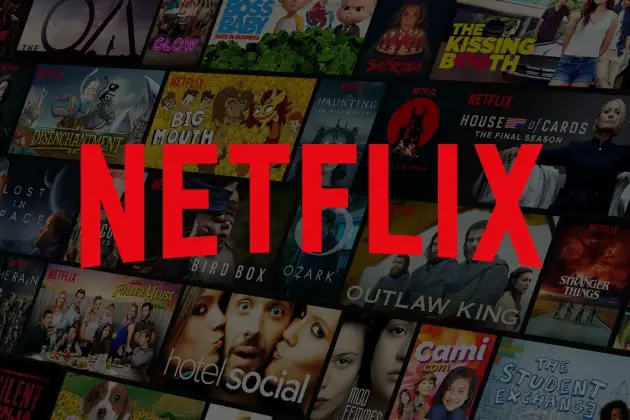 Netflix business strategy is to continuously improve its members’ experience by offering compelling content that delights them and attracts new members. Netflix pioneered subscription streaming in 2007 and retains the first mover competitive advantage in this segment. Moreover, the largest streaming service in the world is pursuing the following strategies: 1. Focusing on revenues maximization over membership growth. Internet-based technology companies such as Netflix often have to choose between growing members or revenues. On one hand, brand recognition at a broad scale requires scaling of the business. On the other hand, scaling requires massive financial investments at the same time when you cannot increase the cost. If you increase the cost, you cannot scale because people will not purchase. This is why internet-based companies such as Uber and Airbnb traded revenues for membership growth and stayed unprofitable for a long time. For Netfix, on the other hand, membership growth is important, but revenue maximization per member is their primary concern. The on-demand media provider regularly increases prices. In the latest move it eliminated its cheapest USD 9,99 add-free plan for its US-based subscribers and the cheapest ad-free tier for new members is because USD15.49 per month in summer 2023.[1] 2.Investing in original content. Netflix is the first company to invest in original content starting with award-winning House of Cards series in 2011. This was followed by a series of quality original content such as BoJack Horseman (2020), Squid Game (2021), Kipo and The Age of Wonderbeasts (2020), Arecane (2021) and many others. Quality original content is one of the main competitive advantages for the on-demand media provider. 3. Staying focused on movies, series and documentaries. Netflix stays within its niche of movies, series and documentaries and the company is planning to continue with this strategy for the foreseeable future. The…
Netflix business strategy is to continuously improve its members’ experience by offering compelling content that delights them and attracts new members. Netflix pioneered subscription streaming in 2007 and retains the first mover competitive advantage in this segment. Moreover, the largest streaming service in the world is pursuing the following strategies: 1. Focusing on revenues maximization over membership growth. Internet-based technology companies such as Netflix often have to choose between growing members or revenues. On one hand, brand recognition at a broad scale requires scaling of the business. On the other hand, scaling requires massive financial investments at the same time when you cannot increase the cost. If you increase the cost, you cannot scale because people will not purchase. This is why internet-based companies such as Uber and Airbnb traded revenues for membership growth and stayed unprofitable for a long time. For Netfix, on the other hand, membership growth is important, but revenue maximization per member is their primary concern. The on-demand media provider regularly increases prices. In the latest move it eliminated its cheapest USD 9,99 add-free plan for its US-based subscribers and the cheapest ad-free tier for new members is because USD15.49 per month in summer 2023.[1] 2.Investing in original content. Netflix is the first company to invest in original content starting with award-winning House of Cards series in 2011. This was followed by a series of quality original content such as BoJack Horseman (2020), Squid Game (2021), Kipo and The Age of Wonderbeasts (2020), Arecane (2021) and many others. Quality original content is one of the main competitive advantages for the on-demand media provider. 3. Staying focused on movies, series and documentaries. Netflix stays within its niche of movies, series and documentaries and the company is planning to continue with this strategy for the foreseeable future. The…Netflix Inc. Report 2023
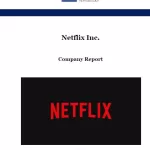 Netflix Inc., the largest streaming service in the world, was incorporated on August 29, 1997 and began operations on April 14, 1998. The entertainment services provider has 231 million paid memberships in over 190 countries. The company employs about 12,800 people in more than 25 countries. Consolidated revenues for the year ended December 31, 2022 increased 6% as compared to the year ended December 31, 2021, due to the 6% growth in average paying memberships and a 1% increase in average monthly revenue per paying membership. Netflix business strategy involves prioritizing revenues maximization over membership growth and increasing investments on original content. Moreover, the streaming service has decided to stay focused on movies, series and documentaries not entering news and live sports segments. The on-demand media provider had change of leadership in 2023 with co-founder Reed Hastings stepping down from the role of co-CEO and Ted Sarandos and Greg Peters becoming new co-CEOs. The largest streaming service in the world has flat organizational culture and its organizational culture has been a subject of case studies in business schools for its unconventionality and effectiveness. Specifically, Netflix organizational culture effectively encourages decision making by employees at all levels and the company has taken information sharing to a whole new level. The popular streaming platform despises rules and communication practices there are candid and direct. Along with its obvious strengths such as first mover advantage, quality original content and global presence, the entertainment services provider has certain weaknesses as well. Namely, Netflix has high level of indebtedness and its business model depends on other companies. Furthermore, the company is over-dependent on North American home market and there is a room for improvement on its customer services. Netflix Inc. Report contains the application of the major analytical strategic frameworks in business studies such as…
Netflix Inc., the largest streaming service in the world, was incorporated on August 29, 1997 and began operations on April 14, 1998. The entertainment services provider has 231 million paid memberships in over 190 countries. The company employs about 12,800 people in more than 25 countries. Consolidated revenues for the year ended December 31, 2022 increased 6% as compared to the year ended December 31, 2021, due to the 6% growth in average paying memberships and a 1% increase in average monthly revenue per paying membership. Netflix business strategy involves prioritizing revenues maximization over membership growth and increasing investments on original content. Moreover, the streaming service has decided to stay focused on movies, series and documentaries not entering news and live sports segments. The on-demand media provider had change of leadership in 2023 with co-founder Reed Hastings stepping down from the role of co-CEO and Ted Sarandos and Greg Peters becoming new co-CEOs. The largest streaming service in the world has flat organizational culture and its organizational culture has been a subject of case studies in business schools for its unconventionality and effectiveness. Specifically, Netflix organizational culture effectively encourages decision making by employees at all levels and the company has taken information sharing to a whole new level. The popular streaming platform despises rules and communication practices there are candid and direct. Along with its obvious strengths such as first mover advantage, quality original content and global presence, the entertainment services provider has certain weaknesses as well. Namely, Netflix has high level of indebtedness and its business model depends on other companies. Furthermore, the company is over-dependent on North American home market and there is a room for improvement on its customer services. Netflix Inc. Report contains the application of the major analytical strategic frameworks in business studies such as…Monday, July 10, 2023
Apple Corporate Social Responsibility (CSR)
 Apple corporate social responsibility (CSR) programs and initiatives are led by Lisa Jackson, Vice President for Environment, Policy and Social Initiatives, reporting directly to CEO Tim Cook. More than 1 million people work in Apple supplier facilities and as such, the company’s operations have considerable implications on the society. It has to be noted that “Steve Jobs wasn’t known for philanthropy. Some wondered if he made anonymous donations to charity, some criticized him for his lack of public giving, while others defended him”[1]. However, with Tim Cook assuming Apple leadership in 2011, the focus on CSR aspect of the business has increased to a considerable extent. Tim Cook is a member of Paulson Institute’s CEO Council for Sustainable Urbanization, working with other CEOs of top Chinese and Western companies to advance sustainability in China. Apple Supporting Local Communities In Oregon, USA, Apple partners with Bluestone Natural Farms to transform compostable materials generated onsite into rich organic material for use on the farm. The tech giant launched a 100-kilowatt rooftop solar project at an educational premise for disadvantaged children in Philippines. The company added 50-kilowatt solar power system and a 260-kilowatt-hour battery to supply clean electricity to off-grid fishing community in Thailand. Apple Educating and Empowering Workers The multinational technology company provided training courses to about 4 million people since 2008. The tech giant has competitive employee benefits practices. For example, expectant mothers can take up to four weeks before a delivery and up to 14 weeks after a birth, while fathers and other non-birth parents are eligible for up to six weeks of parental leave. Apple suppliers paid back USD 32.2 million recruitment fees to their 36,599 employees since 2008. The iPhone maker taught employees organized 185,000 hours of inclusion and diversity training in 2021[2] The company organized 80,000 hours of management…
Apple corporate social responsibility (CSR) programs and initiatives are led by Lisa Jackson, Vice President for Environment, Policy and Social Initiatives, reporting directly to CEO Tim Cook. More than 1 million people work in Apple supplier facilities and as such, the company’s operations have considerable implications on the society. It has to be noted that “Steve Jobs wasn’t known for philanthropy. Some wondered if he made anonymous donations to charity, some criticized him for his lack of public giving, while others defended him”[1]. However, with Tim Cook assuming Apple leadership in 2011, the focus on CSR aspect of the business has increased to a considerable extent. Tim Cook is a member of Paulson Institute’s CEO Council for Sustainable Urbanization, working with other CEOs of top Chinese and Western companies to advance sustainability in China. Apple Supporting Local Communities In Oregon, USA, Apple partners with Bluestone Natural Farms to transform compostable materials generated onsite into rich organic material for use on the farm. The tech giant launched a 100-kilowatt rooftop solar project at an educational premise for disadvantaged children in Philippines. The company added 50-kilowatt solar power system and a 260-kilowatt-hour battery to supply clean electricity to off-grid fishing community in Thailand. Apple Educating and Empowering Workers The multinational technology company provided training courses to about 4 million people since 2008. The tech giant has competitive employee benefits practices. For example, expectant mothers can take up to four weeks before a delivery and up to 14 weeks after a birth, while fathers and other non-birth parents are eligible for up to six weeks of parental leave. Apple suppliers paid back USD 32.2 million recruitment fees to their 36,599 employees since 2008. The iPhone maker taught employees organized 185,000 hours of inclusion and diversity training in 2021[2] The company organized 80,000 hours of management…Apple SWOT Analysis
 SWOT is an acronym for strengths, weaknesses, opportunities and threats related to organizations. The following table illustrates Apple SWOT analysis: Strengths 1. High quality, design and performance of Apple products and services 2. Brand value of more than USD 3 trillion 3. High profit margin 4. Solid financial position of the business 5. Sophisticated supply-chain infrastructure Weaknesses 1. Lack of innovation 2. Decreasing sales of iPhones 3. Higher prices than competition 4. Incompatibility of Apple products and services with other products and services for users 5. Limited customazation options of products Opportunities 1. Further increasing concentration on Services business segment 2. Increasing focus in research and development 3. Product diversification 4. Formation of strategic partnerships 5. Increasing focus on green technology Threats 1. Quality problems with negative effects on sales and Apple brand image 2. Intensifying competition from China and India 3. Being found to have infringed on intellectual property rights 4. Reputation damage due to the tax scandal 5. Disruptive innovation by competitors Apple SWOT analysis Strengths in Apple SWOT Analysis 1. High quality of Apple products and services in terms of design and performance is the main strength of the company. Co-founder and late CEO Steve Jobs never compromised design and functionality because of the cost of raw materials and manufacturing. The same principle persists to this day. The tech giant pursues differentiation business strategy and effectively differentiates its products and services with high quality, design and performance. Moreover, highly sophisticated Apple ecosystem plays an instrumental role in maintaining brand loyalty and consequently sustaining market share in the global scale. Specifically, third-party products are not usually compatible with Apple products and all products belonging to Apple portfolio work well with each-other. Thanks to services such as iCloud, airplay, and airdrop, you can start a task in on…
SWOT is an acronym for strengths, weaknesses, opportunities and threats related to organizations. The following table illustrates Apple SWOT analysis: Strengths 1. High quality, design and performance of Apple products and services 2. Brand value of more than USD 3 trillion 3. High profit margin 4. Solid financial position of the business 5. Sophisticated supply-chain infrastructure Weaknesses 1. Lack of innovation 2. Decreasing sales of iPhones 3. Higher prices than competition 4. Incompatibility of Apple products and services with other products and services for users 5. Limited customazation options of products Opportunities 1. Further increasing concentration on Services business segment 2. Increasing focus in research and development 3. Product diversification 4. Formation of strategic partnerships 5. Increasing focus on green technology Threats 1. Quality problems with negative effects on sales and Apple brand image 2. Intensifying competition from China and India 3. Being found to have infringed on intellectual property rights 4. Reputation damage due to the tax scandal 5. Disruptive innovation by competitors Apple SWOT analysis Strengths in Apple SWOT Analysis 1. High quality of Apple products and services in terms of design and performance is the main strength of the company. Co-founder and late CEO Steve Jobs never compromised design and functionality because of the cost of raw materials and manufacturing. The same principle persists to this day. The tech giant pursues differentiation business strategy and effectively differentiates its products and services with high quality, design and performance. Moreover, highly sophisticated Apple ecosystem plays an instrumental role in maintaining brand loyalty and consequently sustaining market share in the global scale. Specifically, third-party products are not usually compatible with Apple products and all products belonging to Apple portfolio work well with each-other. Thanks to services such as iCloud, airplay, and airdrop, you can start a task in on…Thursday, July 6, 2023
Apple PESTEL Analysis
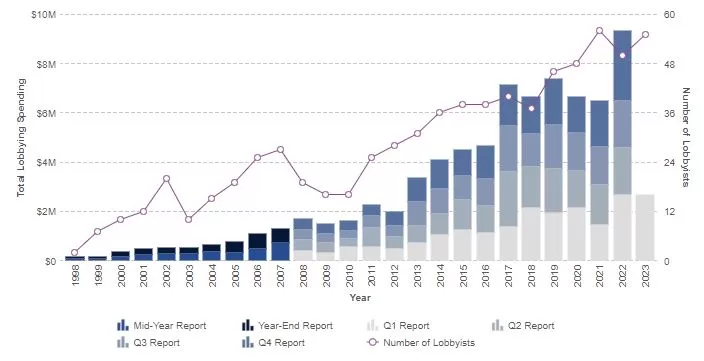 PESTEL is a strategic analytical tool and the acronym stands for political, economic, social, technological, environmental and legal factors. Apple PESTEL analysis (or Apple PESTLE analysis) involves the analysis of potential impact of these factors on the bottom line and long-term growth prospects for the tech giant. Political Factors in Apple PESTEL Analysis The extent to which Apple is able to achieve its primary objective of profit maximization depends on a wide range of political factors. These include government stability, level of bureaucracy, corruption, freedom of press, home market lobbying groups etc. Additionally, activities of trade unions can be mentioned as important external political factors for Apple. Tax Payments The payment of taxes is a noteworthy political factor affecting Apple. The multinational technology company uses complex legal means to keep its tax payments as low as possible globally, especially in the US and Ireland. In the US, the tech giant holds the majority of its cash offshore so that it can avoid paying corporate income taxes in the US.[1] Any changes in government taxation policies may affect the bottom line for the iPhone maker. In Europe, European Commission concluded that Apple should have paid the Irish state at least €14 billion (USD 16.2 billion) in corporate tax for 2004-2014. However, in 2020 the General Court of the European Union ruled that European Commission was wrong, a decision that was welcomed by the Irish government.[2] Changes in taxation policies in general and the stance of governments and government agencies towards the iPhone maker in particular are external political factors that have implications for the business. Dispute with US Federal Bureau of Investigations The most significant case that illustrates the potential impact of a political factor relates to Apple’s battle with US Federal Bureau of Investigations (FBI). Specifically, the…
PESTEL is a strategic analytical tool and the acronym stands for political, economic, social, technological, environmental and legal factors. Apple PESTEL analysis (or Apple PESTLE analysis) involves the analysis of potential impact of these factors on the bottom line and long-term growth prospects for the tech giant. Political Factors in Apple PESTEL Analysis The extent to which Apple is able to achieve its primary objective of profit maximization depends on a wide range of political factors. These include government stability, level of bureaucracy, corruption, freedom of press, home market lobbying groups etc. Additionally, activities of trade unions can be mentioned as important external political factors for Apple. Tax Payments The payment of taxes is a noteworthy political factor affecting Apple. The multinational technology company uses complex legal means to keep its tax payments as low as possible globally, especially in the US and Ireland. In the US, the tech giant holds the majority of its cash offshore so that it can avoid paying corporate income taxes in the US.[1] Any changes in government taxation policies may affect the bottom line for the iPhone maker. In Europe, European Commission concluded that Apple should have paid the Irish state at least €14 billion (USD 16.2 billion) in corporate tax for 2004-2014. However, in 2020 the General Court of the European Union ruled that European Commission was wrong, a decision that was welcomed by the Irish government.[2] Changes in taxation policies in general and the stance of governments and government agencies towards the iPhone maker in particular are external political factors that have implications for the business. Dispute with US Federal Bureau of Investigations The most significant case that illustrates the potential impact of a political factor relates to Apple’s battle with US Federal Bureau of Investigations (FBI). Specifically, the…Wednesday, July 5, 2023
Apple Ecosystem: closed and effective
 Ecosystem in its essence is “a biological community of interacting organisms”[1]. In technology terms, ecosystem refers to a group of devices and software that represent a single collaborative network. In other words, it is how well each product or service belonging to a company work individually and if end-users will get better experience when all of these products and services work together. It is the question if the whole is greater than sum of all parts. Apple ecosystem is one of the main competitive advantages associated with the brand. In fact, the iPhone maker is one of the earliest technology companies globally to purposefully form an ecosystem. Third-party products are not usually compatible with Apple products and all products belonging to Apple portfolio work well with each-other. At the same time, the ecosystem of Apple is much more than just a collection of more than 2 billion active devices[2] or services that work seamlessly. Apple ecosystem integrates the following key elements: Company image of creativity that motivates customers to upgrade their devices frequently. Perception of status and effectiveness that is associated with using Apple products Efficient devices and services that perform best with other Apple products and services Apple ID is the cornerstone of the ecosystem. It is used to register all Apple devices. Advantages of Apple Ecosystem Thanks to services such as iCloud, airplay, and airdrop, one can start a task in on one Apple device and continue it on another and there is no need to download or install anything. Moreover, Apple ecosystem offers features like AirDrop, iMessage, and FaceTime on macOS; unlocking a Mac laptop with an Apple Watch; or auto-pairing and finding lost AirPods, and the list goes on. Today, Apple ecosystem is widely considered to be the best in the industry, and arguably in…
Ecosystem in its essence is “a biological community of interacting organisms”[1]. In technology terms, ecosystem refers to a group of devices and software that represent a single collaborative network. In other words, it is how well each product or service belonging to a company work individually and if end-users will get better experience when all of these products and services work together. It is the question if the whole is greater than sum of all parts. Apple ecosystem is one of the main competitive advantages associated with the brand. In fact, the iPhone maker is one of the earliest technology companies globally to purposefully form an ecosystem. Third-party products are not usually compatible with Apple products and all products belonging to Apple portfolio work well with each-other. At the same time, the ecosystem of Apple is much more than just a collection of more than 2 billion active devices[2] or services that work seamlessly. Apple ecosystem integrates the following key elements: Company image of creativity that motivates customers to upgrade their devices frequently. Perception of status and effectiveness that is associated with using Apple products Efficient devices and services that perform best with other Apple products and services Apple ID is the cornerstone of the ecosystem. It is used to register all Apple devices. Advantages of Apple Ecosystem Thanks to services such as iCloud, airplay, and airdrop, one can start a task in on one Apple device and continue it on another and there is no need to download or install anything. Moreover, Apple ecosystem offers features like AirDrop, iMessage, and FaceTime on macOS; unlocking a Mac laptop with an Apple Watch; or auto-pairing and finding lost AirPods, and the list goes on. Today, Apple ecosystem is widely considered to be the best in the industry, and arguably in…Tuesday, July 4, 2023
Apple Organizational Culture Secrecy and Maximum Benefit from Human Resources
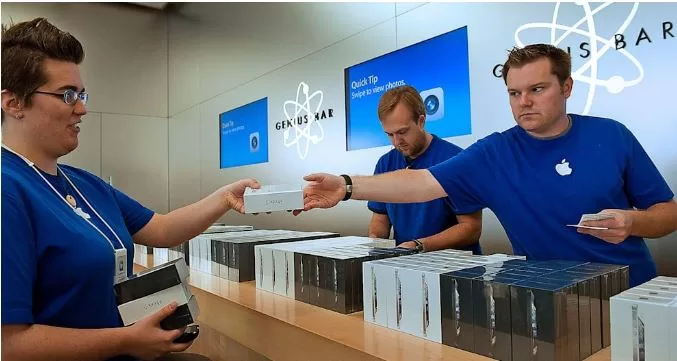 Corporate culture of Apple plays an important role in efficiently maintaining its operations in the global scale with 164,000 full-time equivalent employees.[1] Apple organizational culture used to have a reputation of being harsh, demanding and intimidating under the leadership of founder and late CEO Steve Jobs. However, it can be argued that since assuming the top leadership in 2011, Tim Cook has invested considerable efforts towards ‘humanising’ the brand. Specifically, unlike his predecessor, Tim Cook has spoken out about human rights, privacy, immigration reform and environmental issues.[2] Apple corporate culture integrates the following important features: 1. Creativity and innovativeness. Apple pursues the business strategy of product differentiation with the focus on the design and functionality of products and services. An effective implementation of this strategy in practice requires a high level of creativity and innovativeness from employees at all levels. Accordingly, in order to encourage their employees to be more creative and innovative, the company attempts to develop relevant working environment. Creative design of Apple Campus, informal dress codes and creatively designed working space can be mentioned to illustrate this point. 2. Working under pressure. Ability to work under pressure is a must-have skill for Apple employees at all levels. In fact, it is challenging to work for the first company ever to be valued at $3 trillion. Most projects have strict and short deadlines and working long hours is a norm in the company. CEO Tim Cook sets example in terms of his loyalty to the company and working long hours. He is known for sending emails to employees at 4:30 am. Moreover, Sunday is a work night for many managers at Apple because of the executive meeting the next day. Not everyone can sustain to work at such an intense rate. But employees who survive within the first…
Corporate culture of Apple plays an important role in efficiently maintaining its operations in the global scale with 164,000 full-time equivalent employees.[1] Apple organizational culture used to have a reputation of being harsh, demanding and intimidating under the leadership of founder and late CEO Steve Jobs. However, it can be argued that since assuming the top leadership in 2011, Tim Cook has invested considerable efforts towards ‘humanising’ the brand. Specifically, unlike his predecessor, Tim Cook has spoken out about human rights, privacy, immigration reform and environmental issues.[2] Apple corporate culture integrates the following important features: 1. Creativity and innovativeness. Apple pursues the business strategy of product differentiation with the focus on the design and functionality of products and services. An effective implementation of this strategy in practice requires a high level of creativity and innovativeness from employees at all levels. Accordingly, in order to encourage their employees to be more creative and innovative, the company attempts to develop relevant working environment. Creative design of Apple Campus, informal dress codes and creatively designed working space can be mentioned to illustrate this point. 2. Working under pressure. Ability to work under pressure is a must-have skill for Apple employees at all levels. In fact, it is challenging to work for the first company ever to be valued at $3 trillion. Most projects have strict and short deadlines and working long hours is a norm in the company. CEO Tim Cook sets example in terms of his loyalty to the company and working long hours. He is known for sending emails to employees at 4:30 am. Moreover, Sunday is a work night for many managers at Apple because of the executive meeting the next day. Not everyone can sustain to work at such an intense rate. But employees who survive within the first…Sunday, July 2, 2023
Apple Ansoff Matrix
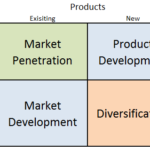 Apple Ansoff Matrix is a marketing planning model that helps the multinational technology company to determine its product and market strategy. Ansoff Matrix illustrates four different strategy options available for businesses. These are market penetration, product development, market development and diversification. Apple Ansoff Growth Matrix Within the scope of Ansoff Matrix, Apple uses all four growth strategies in an integrated manner: 1. Market penetration. Market penetration refers to selling existing products to existing markets. Existing market for Apple consists of its global operations divided into five operating segments: Americas, Europe, Greater China, Japan and Rest of Asian Pacific. The tech giant operates more than 518 retail stores in 25 countries and regions.[1] Apple engages in market penetration strategy via effective application of marketing strategy. Apple’s ecosystem of products and services also plays an instrumental role in pursuing market penetration strategy with high level of efficiency. 2. Product development. This involves developing new products to sell to existing markets. New product development in a regular manner is one of the core growth strategies pursued by Apple. Each new product or service by Apple nicely fits within its ecosystem and serves to further strengthen the company ecosystem. Moreover, the multinational technology company regularly introduces updated versions of its existing products and services and introduces totally new products. The company’s investments on research and development for new products has increased from USD 0,78 billion in 2007 to USD 25,3 billion in 2023. 3. Market development. Market development strategy is associated with finding new markets for existing products. This strategy has been adapted as the main growth strategy by Apple. Specifically, the world’s largest IT company by revenue focuses of emerging economies in Asia as attractive markets for long-term perspective. The multinational technology company appeals to local culture and sentiment when developing marketing strategies…
Apple Ansoff Matrix is a marketing planning model that helps the multinational technology company to determine its product and market strategy. Ansoff Matrix illustrates four different strategy options available for businesses. These are market penetration, product development, market development and diversification. Apple Ansoff Growth Matrix Within the scope of Ansoff Matrix, Apple uses all four growth strategies in an integrated manner: 1. Market penetration. Market penetration refers to selling existing products to existing markets. Existing market for Apple consists of its global operations divided into five operating segments: Americas, Europe, Greater China, Japan and Rest of Asian Pacific. The tech giant operates more than 518 retail stores in 25 countries and regions.[1] Apple engages in market penetration strategy via effective application of marketing strategy. Apple’s ecosystem of products and services also plays an instrumental role in pursuing market penetration strategy with high level of efficiency. 2. Product development. This involves developing new products to sell to existing markets. New product development in a regular manner is one of the core growth strategies pursued by Apple. Each new product or service by Apple nicely fits within its ecosystem and serves to further strengthen the company ecosystem. Moreover, the multinational technology company regularly introduces updated versions of its existing products and services and introduces totally new products. The company’s investments on research and development for new products has increased from USD 0,78 billion in 2007 to USD 25,3 billion in 2023. 3. Market development. Market development strategy is associated with finding new markets for existing products. This strategy has been adapted as the main growth strategy by Apple. Specifically, the world’s largest IT company by revenue focuses of emerging economies in Asia as attractive markets for long-term perspective. The multinational technology company appeals to local culture and sentiment when developing marketing strategies…Apple Organizational Structure: a brief overview
 Apple organizational structure can be described as hierarchical and functional. Such a structure has been developed by its founder and former CEO late Steve Jobs in order to ensure focused realization of his innovative ideas and clear vision for the business. When Steve Jobs returned to turnaround failing Apple in 1997 the company had a typical organizational structure with many business units with their own profit and loss (P&L) responsibilities. In order to increase the coherence and fuel innovation, Jobs fired general managers of all business units (within one day) and put in place one P&L for the entire business. Apple organizational structure has been subjected to certain modifications since the leadership role was assumed by Tim Cook on August 2011. Specifically, Mr. Cook embraced the decentralization of decision making to a certain extent in order to encourage innovation and creativity at various levels. Also, Cook divided hardware function into hardware engineering and hardware technologies. As the most recent change to the corporate structure Cook added artificial intelligence (AI) and machine learning as separate function areas due the increasing importance of AI and machine learning. Currently, Apple organizational structure has the format illustrated in figure below: Apple Organizational Structure Generally, Apple corporate structure has the following characteristics: 1. Hierarchical organizational structure. Although Tim Cook introduced considerable changes to Apple corporate structure since assuming the top job in 2011, the structure still remains to be highly hierarchical with many layers of management. Massive size of the company that comprises 164,000 full-time equivalent employees globally necessitates the adherence to the hierarchical organisational structure. Advantages of Apple hierarchical organizational structure include tight control possessed by senior management over all aspects of the business. Moreover, promotion opportunities motivate employees to perform well and there are clear levels of authority and responsibility. On the negative…
Apple organizational structure can be described as hierarchical and functional. Such a structure has been developed by its founder and former CEO late Steve Jobs in order to ensure focused realization of his innovative ideas and clear vision for the business. When Steve Jobs returned to turnaround failing Apple in 1997 the company had a typical organizational structure with many business units with their own profit and loss (P&L) responsibilities. In order to increase the coherence and fuel innovation, Jobs fired general managers of all business units (within one day) and put in place one P&L for the entire business. Apple organizational structure has been subjected to certain modifications since the leadership role was assumed by Tim Cook on August 2011. Specifically, Mr. Cook embraced the decentralization of decision making to a certain extent in order to encourage innovation and creativity at various levels. Also, Cook divided hardware function into hardware engineering and hardware technologies. As the most recent change to the corporate structure Cook added artificial intelligence (AI) and machine learning as separate function areas due the increasing importance of AI and machine learning. Currently, Apple organizational structure has the format illustrated in figure below: Apple Organizational Structure Generally, Apple corporate structure has the following characteristics: 1. Hierarchical organizational structure. Although Tim Cook introduced considerable changes to Apple corporate structure since assuming the top job in 2011, the structure still remains to be highly hierarchical with many layers of management. Massive size of the company that comprises 164,000 full-time equivalent employees globally necessitates the adherence to the hierarchical organisational structure. Advantages of Apple hierarchical organizational structure include tight control possessed by senior management over all aspects of the business. Moreover, promotion opportunities motivate employees to perform well and there are clear levels of authority and responsibility. On the negative…Apple Leadership: a brief overview
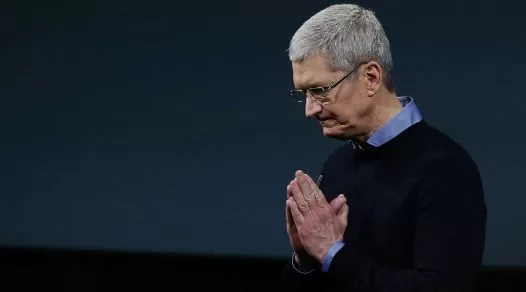 During Steve Jobs era that covers the period 1997 – 2011, Apple leadership was autocratic with Steve Jobs micro-managing a wide range of business operations. It has been noted that “when Steve Jobs was in charge, everything flowed through him.”[1] Apple leadership practices have changed dramatically under Tim Cook. Acknowledged as the World’s Greatest Leader by Fortune Magazine[2], Tim Cook proved to be effective from various perspectives. Moreover, Tim Cook has been praised by employees for inspirational leadership and helping his subordinates to become a better human being.[3] The multinational technology company is parting with perfectionism and autocracy elements of leadership that had prevailed under Steve Jobs. Apple leadership style integrates the following elements: 1. Democratic leadership style. In contrast to highly autocratic leadership style of Apple co-founder and late CEO Steve Jobs, the current CEO Tim Cook exercises and promotes democratic leadership. For Cook, it is important to build consensus among senior management regarding strategic decisions for the ebusiness. Moreover, since assuming the top role, Cook granted greater autonomy to new product development team, decreasing the direct participation of the CEO in new product development process. 2. “Quiet” leadership. Tim Cook has been praised for his quiet, yet effective leadership style. Nicknamed as “quiet leader” by some industry analysts[4], Cook is totally different from his charismatic predecessor, Steve Jobs. At the same time, Tim Cook is occasionally criticized by analysts and industry watchers for the lack of ambition and vigour, his predecessor Steve Jobs had. For example, according to a report by BGC financial services firm, “under Cook, Apple has been cautious about entering new product categories. The Apple Watch, launched in April 2015, is the No. 1 smartwatch, but overall sales have disappointed. Apple Music, which debuted in June 2015, has grown rapidly to 15 million subscribers, but…
During Steve Jobs era that covers the period 1997 – 2011, Apple leadership was autocratic with Steve Jobs micro-managing a wide range of business operations. It has been noted that “when Steve Jobs was in charge, everything flowed through him.”[1] Apple leadership practices have changed dramatically under Tim Cook. Acknowledged as the World’s Greatest Leader by Fortune Magazine[2], Tim Cook proved to be effective from various perspectives. Moreover, Tim Cook has been praised by employees for inspirational leadership and helping his subordinates to become a better human being.[3] The multinational technology company is parting with perfectionism and autocracy elements of leadership that had prevailed under Steve Jobs. Apple leadership style integrates the following elements: 1. Democratic leadership style. In contrast to highly autocratic leadership style of Apple co-founder and late CEO Steve Jobs, the current CEO Tim Cook exercises and promotes democratic leadership. For Cook, it is important to build consensus among senior management regarding strategic decisions for the ebusiness. Moreover, since assuming the top role, Cook granted greater autonomy to new product development team, decreasing the direct participation of the CEO in new product development process. 2. “Quiet” leadership. Tim Cook has been praised for his quiet, yet effective leadership style. Nicknamed as “quiet leader” by some industry analysts[4], Cook is totally different from his charismatic predecessor, Steve Jobs. At the same time, Tim Cook is occasionally criticized by analysts and industry watchers for the lack of ambition and vigour, his predecessor Steve Jobs had. For example, according to a report by BGC financial services firm, “under Cook, Apple has been cautious about entering new product categories. The Apple Watch, launched in April 2015, is the No. 1 smartwatch, but overall sales have disappointed. Apple Music, which debuted in June 2015, has grown rapidly to 15 million subscribers, but…Saturday, July 1, 2023
Apple Value Chain Analysis
 Apple value chain analysis is an analytical framework that assists in identifying business activities that can create value and competitive advantage to the business. Figure 1 below illustrates the essence of Apple value chain analysis. Figure 1 Apple Value Chain Analysis Apple Primary Activities Apple Inbound logistics Inbound logistics primary activity refers to receiving and storing of raw materials for their consecutive use in manufacturing. Apple works with hundreds of suppliers around the globe and maintains a highly sophisticated supply-chain management as illustrated in Figure 2 below. Figure 2 Apple operations roadmap[1] Apple supply chain involves more than 3 million people working for thousands of businesses in 52 countries[2] The multinational technology company’s purchase commitments typically cover its requirements for periods up to 150 days[3]. Tim Cook is an experienced word-class supply chain professional. Steve Jobs had convinced him to join Apple as head of supply chain in 1998 when the tech giant was in trouble, risking the bankruptcy. As part of massive supply chain turnover Tim Cook cut the numbers of suppliers, reduced the number of warehouses by half and established relationships with contract manufacturers. Cook has been able to reduce Apple inventory turn over from 1 month to 2-5 days. Cook further reduced the numbers of suppliers after becoming CEO in 2011. As a result of these and other initiatives, Apple supply chain practices have become a benchmark for efficiency for global businesses. The main sources of value in Apple inbound logistics relate to the economies of scale due to the massive scope and scale of business operations as discussed below and the development of strategic relationships with suppliers. Moreover, Apple Inc. exercises an immense bargaining power in dealing with its suppliers and as a result, the company is able to secure cost advantage in the purchase of…
Apple value chain analysis is an analytical framework that assists in identifying business activities that can create value and competitive advantage to the business. Figure 1 below illustrates the essence of Apple value chain analysis. Figure 1 Apple Value Chain Analysis Apple Primary Activities Apple Inbound logistics Inbound logistics primary activity refers to receiving and storing of raw materials for their consecutive use in manufacturing. Apple works with hundreds of suppliers around the globe and maintains a highly sophisticated supply-chain management as illustrated in Figure 2 below. Figure 2 Apple operations roadmap[1] Apple supply chain involves more than 3 million people working for thousands of businesses in 52 countries[2] The multinational technology company’s purchase commitments typically cover its requirements for periods up to 150 days[3]. Tim Cook is an experienced word-class supply chain professional. Steve Jobs had convinced him to join Apple as head of supply chain in 1998 when the tech giant was in trouble, risking the bankruptcy. As part of massive supply chain turnover Tim Cook cut the numbers of suppliers, reduced the number of warehouses by half and established relationships with contract manufacturers. Cook has been able to reduce Apple inventory turn over from 1 month to 2-5 days. Cook further reduced the numbers of suppliers after becoming CEO in 2011. As a result of these and other initiatives, Apple supply chain practices have become a benchmark for efficiency for global businesses. The main sources of value in Apple inbound logistics relate to the economies of scale due to the massive scope and scale of business operations as discussed below and the development of strategic relationships with suppliers. Moreover, Apple Inc. exercises an immense bargaining power in dealing with its suppliers and as a result, the company is able to secure cost advantage in the purchase of…Friday, June 30, 2023
Apple Porters Five Forces Analysis
 Porter’s Five Forces analytical framework developed by Michael Porter (1979)[1] represents five individual forces that shape the overall extent of competition in the industry. Apple Porter’s Five Forces are represented in Figure 1 below: Figure 1 Porter’s Five Forces Threat of new entrants in Apple Porter’s Five Forces Analysis Threat of new entrants into consumer electronics industry is not substantial. The following factors, among others, determine the threat of new entrants into the industry to compete with Apple: 1. Massive capital requirements. Manufacturing technological devices and producing operating systems require massive capital investments. As illustrated in Table 1 below, the top players in the market invest billions of dollars in R&D in order to keep the pipeline of new products and services active. New market entrants will have to produce new products and services that will have to compete with products and services of top players that invest billions of dollars every year in R&D. Rank Company R&D spending (USD) 1 Amazon 70.3 billion 2 Alphabet 38.1 billion 3 Meta Platforms 34.0 billion 4 Apple 25.3 billion 5 Microsoft 23.0 billion 6 Samsung Electronics 18.2 billion 7 Intel 17.5 billion 8 Roche 16.0 billion 9 Volkswagen 14.0 billion 10 Johnson & Johnson 14.0 billion Table 1 Top R&D spenders among technology companies in 2022 Moreover, capital is needed to obtain resources in general and to attract human resources and talented employees in particular. Accordingly, it is safe to argue that access to capital can prove to be a substantial entry barrier for new businesses. 2. Economies of scale. Economies of scale are substantial entry barrier into consumer electronics and tech industry. New players will find it difficult to compete with established global brands such as Apple, Samsung, Google and HTC that are able to gain cost advantage…
Porter’s Five Forces analytical framework developed by Michael Porter (1979)[1] represents five individual forces that shape the overall extent of competition in the industry. Apple Porter’s Five Forces are represented in Figure 1 below: Figure 1 Porter’s Five Forces Threat of new entrants in Apple Porter’s Five Forces Analysis Threat of new entrants into consumer electronics industry is not substantial. The following factors, among others, determine the threat of new entrants into the industry to compete with Apple: 1. Massive capital requirements. Manufacturing technological devices and producing operating systems require massive capital investments. As illustrated in Table 1 below, the top players in the market invest billions of dollars in R&D in order to keep the pipeline of new products and services active. New market entrants will have to produce new products and services that will have to compete with products and services of top players that invest billions of dollars every year in R&D. Rank Company R&D spending (USD) 1 Amazon 70.3 billion 2 Alphabet 38.1 billion 3 Meta Platforms 34.0 billion 4 Apple 25.3 billion 5 Microsoft 23.0 billion 6 Samsung Electronics 18.2 billion 7 Intel 17.5 billion 8 Roche 16.0 billion 9 Volkswagen 14.0 billion 10 Johnson & Johnson 14.0 billion Table 1 Top R&D spenders among technology companies in 2022 Moreover, capital is needed to obtain resources in general and to attract human resources and talented employees in particular. Accordingly, it is safe to argue that access to capital can prove to be a substantial entry barrier for new businesses. 2. Economies of scale. Economies of scale are substantial entry barrier into consumer electronics and tech industry. New players will find it difficult to compete with established global brands such as Apple, Samsung, Google and HTC that are able to gain cost advantage…Thursday, June 29, 2023
Apple Marketing Communication Mix
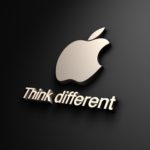 Apple marketing communication mix explains the company’s stance towards individual elements of the marketing communication mix such as print and media advertising, sales promotions, events and experiences, public relations, direct marketing and personal selling. The main aim behind Apple marketing communications mix is to communicate the marketing message of the brand to the target customer segment through elements listed above. Apple is effective in using elements of the marketing communication mix in an integrated manner to ensure the consistency of the marketing message. Apple Print and Media Advertising Since its foundation more than 40 years ago Apple has been using print and media advertising extensively to promote the brand in general and new products in particular. Some of the ads by the tech giant have become truly iconic raising the bar for advertisement globally. The following is the list of the most memorable print and media advertising campaigns launched by Apple: “1984” campaign directed by Ridley Scott and first shown during 1984 Super Bowl is widely considered as one of the most successful marketing campaigns of all times “The Quadra Revolution” is 1991 campaign that was a successful attempt by the tech giant to further itself ahead of the competition at the beginning of the digital age of 90s “Misunderstood”, a Christmas ad of 2013 won Emmy Award for the year’s most “Outstanding Commercial.” “40 Years in 40 Seconds” is a viral video that chronicles 40 years of the company in 40 seconds “Meu Bloco na Rua” (2017) is the latest ad released in Brazil for the Rio Carnival, highlighting the iPhone 7 Plus’ new portrait photography mode Apple also uses celebrity endorsements in print and media advertising extensively. In the past Apple’s ‘Think Different’ print and media advertising materials featured the images of innovators and pioneers in different areas…
Apple marketing communication mix explains the company’s stance towards individual elements of the marketing communication mix such as print and media advertising, sales promotions, events and experiences, public relations, direct marketing and personal selling. The main aim behind Apple marketing communications mix is to communicate the marketing message of the brand to the target customer segment through elements listed above. Apple is effective in using elements of the marketing communication mix in an integrated manner to ensure the consistency of the marketing message. Apple Print and Media Advertising Since its foundation more than 40 years ago Apple has been using print and media advertising extensively to promote the brand in general and new products in particular. Some of the ads by the tech giant have become truly iconic raising the bar for advertisement globally. The following is the list of the most memorable print and media advertising campaigns launched by Apple: “1984” campaign directed by Ridley Scott and first shown during 1984 Super Bowl is widely considered as one of the most successful marketing campaigns of all times “The Quadra Revolution” is 1991 campaign that was a successful attempt by the tech giant to further itself ahead of the competition at the beginning of the digital age of 90s “Misunderstood”, a Christmas ad of 2013 won Emmy Award for the year’s most “Outstanding Commercial.” “40 Years in 40 Seconds” is a viral video that chronicles 40 years of the company in 40 seconds “Meu Bloco na Rua” (2017) is the latest ad released in Brazil for the Rio Carnival, highlighting the iPhone 7 Plus’ new portrait photography mode Apple also uses celebrity endorsements in print and media advertising extensively. In the past Apple’s ‘Think Different’ print and media advertising materials featured the images of innovators and pioneers in different areas…Apple Segmentation Targeting and Positioning
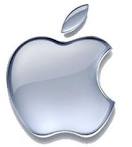 Apple segmentation, targeting and positioning represents the core of its marketing efforts. Segmentation, targeting and positioning is needed because no company or product can be all things to all people. Apple segmentation targeting and positioning initiatives include the following stages: 1. Segmenting the market. Segmentation involves dividing population into groups according to certain characteristics. Specifically, customers can be segmented on the basis of their place of living, demographic variables, behavioural traits, psychographic characteristics and other variables. Market segments need to be measurable, accessible, sustainable and actionable in order to be used for marketing purposes. 2. Targeting selected segment(s). This stage involves identifying segments that are most attractive for the business. In other words, targeting implies choosing specific groups identified as a result of segmentation to sell products to. The multinational technology company positions itself as a premium brand offering products and services with advanced functions and capabilities for additional costs. Accordingly, Apple target customer segment comprise well-off individuals who are willing to pay extra for technology products and services with advanced design, functions and capabilities. A common set of characteristics shared by Apple target customer segment include appreciating design, quality and performance of technology products and services over their prices. 3. Positioning the offering. Positioning refers to the selection of the marketing mix that is the most suitable for the target customer segment. It is the final process, where companies attempt to associate their products and services with needs and wants of selected customer segment. Apple targets its customer segment by tailoring products, services and overall business approach to appeal to the members of segment to a maximum extent. Under the leadership of late Steve Jobs, Apple mainly used mono-segment type of positioning, appealing to the needs and wants of a single customer segment. However, after Tim Cook became CEO,…
Apple segmentation, targeting and positioning represents the core of its marketing efforts. Segmentation, targeting and positioning is needed because no company or product can be all things to all people. Apple segmentation targeting and positioning initiatives include the following stages: 1. Segmenting the market. Segmentation involves dividing population into groups according to certain characteristics. Specifically, customers can be segmented on the basis of their place of living, demographic variables, behavioural traits, psychographic characteristics and other variables. Market segments need to be measurable, accessible, sustainable and actionable in order to be used for marketing purposes. 2. Targeting selected segment(s). This stage involves identifying segments that are most attractive for the business. In other words, targeting implies choosing specific groups identified as a result of segmentation to sell products to. The multinational technology company positions itself as a premium brand offering products and services with advanced functions and capabilities for additional costs. Accordingly, Apple target customer segment comprise well-off individuals who are willing to pay extra for technology products and services with advanced design, functions and capabilities. A common set of characteristics shared by Apple target customer segment include appreciating design, quality and performance of technology products and services over their prices. 3. Positioning the offering. Positioning refers to the selection of the marketing mix that is the most suitable for the target customer segment. It is the final process, where companies attempt to associate their products and services with needs and wants of selected customer segment. Apple targets its customer segment by tailoring products, services and overall business approach to appeal to the members of segment to a maximum extent. Under the leadership of late Steve Jobs, Apple mainly used mono-segment type of positioning, appealing to the needs and wants of a single customer segment. However, after Tim Cook became CEO,…Sunday, June 25, 2023
Nvidia Marketing Communication Mix
 Nvidia marketing communication mix includes the use of various communication channels to transmit the marketing message to the target customer segment. These channels are print and media advertising, sales promotions, events and experiences, public relations and direct marketing. Nvidia Print and Media Advertising Nvidia uses print and media as an effective advertising platform systematically. Specifically, the multinational technology company runs advertising campaigns on TV and radio channels, as well as magazines and newspapers popular with their target customer segment. Additionally, Nvidia places large billboards in crowded area in large metropolitan cities. The software and fables company also uses viral marketing extensively on popular social media platforms such as Twitter, LinkedIn, and YouTube. Nvidia also uses product placement strategy by Nvidia include a science fiction movie “Blade Runner 2049” released in 2017 and Steven Spielberg film “Ready Player One” released in 2018. Nvidia Sales Promotions Nvidia uses various sales promotions techniques regularly to increase its revenues. Specifically, the multinational technology company uses the following sales promotions techniques: – Seasonal sales promotions. Nvidia uses seasonal sales promotions to boost its revenues during holidays and festive seasons. Additionally, the company runs promotions during major industry events such as the Consumer Electronics Show or the Game Developers Conference. – Money off coupons. Nvidia does not offer money off coupons to end-users directly, but its distributors use this particular sales promotions technique regularly. – Free gifts. The company offers free gifts occasionally as part of its marketing strategy. For example, in 2023 Nvidia offered Marvel’s Midnight Suns Captain Marvel’sMedieval Marvel Suit free of charge to users of graphics cards GeForce GTX 10 and above. Nvidia Corporation Report contains a full analysis of Nvidia marketing communication mix and Nvidia marketing strategy in general. The report illustrates the application of the major analytical strategic…
Nvidia marketing communication mix includes the use of various communication channels to transmit the marketing message to the target customer segment. These channels are print and media advertising, sales promotions, events and experiences, public relations and direct marketing. Nvidia Print and Media Advertising Nvidia uses print and media as an effective advertising platform systematically. Specifically, the multinational technology company runs advertising campaigns on TV and radio channels, as well as magazines and newspapers popular with their target customer segment. Additionally, Nvidia places large billboards in crowded area in large metropolitan cities. The software and fables company also uses viral marketing extensively on popular social media platforms such as Twitter, LinkedIn, and YouTube. Nvidia also uses product placement strategy by Nvidia include a science fiction movie “Blade Runner 2049” released in 2017 and Steven Spielberg film “Ready Player One” released in 2018. Nvidia Sales Promotions Nvidia uses various sales promotions techniques regularly to increase its revenues. Specifically, the multinational technology company uses the following sales promotions techniques: – Seasonal sales promotions. Nvidia uses seasonal sales promotions to boost its revenues during holidays and festive seasons. Additionally, the company runs promotions during major industry events such as the Consumer Electronics Show or the Game Developers Conference. – Money off coupons. Nvidia does not offer money off coupons to end-users directly, but its distributors use this particular sales promotions technique regularly. – Free gifts. The company offers free gifts occasionally as part of its marketing strategy. For example, in 2023 Nvidia offered Marvel’s Midnight Suns Captain Marvel’sMedieval Marvel Suit free of charge to users of graphics cards GeForce GTX 10 and above. Nvidia Corporation Report contains a full analysis of Nvidia marketing communication mix and Nvidia marketing strategy in general. The report illustrates the application of the major analytical strategic…Friday, June 23, 2023
Nvidia Ecosystem Overview
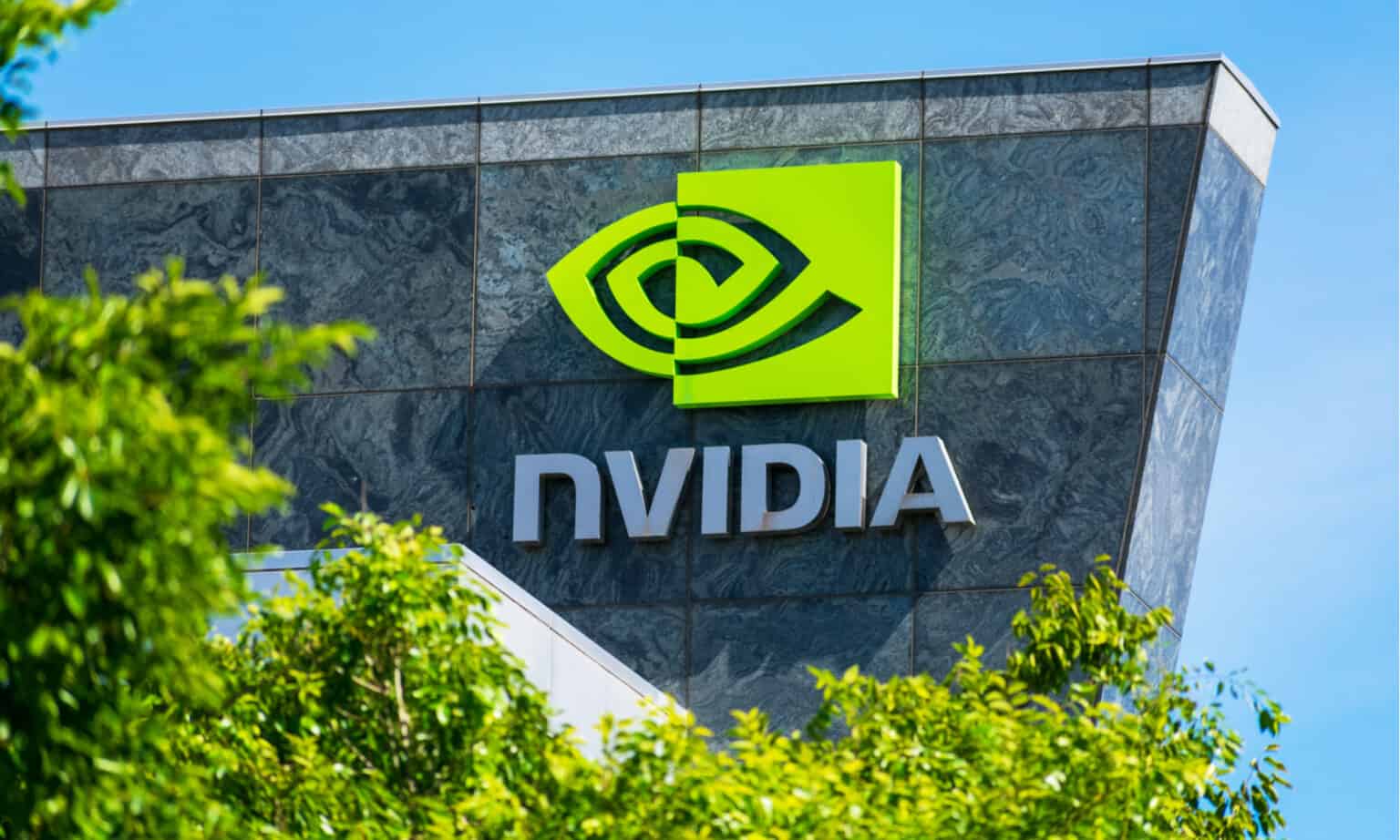 Nvidia ecosystem refers to the network of interconnected components, technologies, and partners that work together to support the company’s products and services. The following are the key elements of Nvidia ecosystem: 1. Products. The core of Nvidia’s ecosystem is its products, which include graphics cards, data centre products, and system-on-a-chip (SoC) products. These products form the foundation of the ecosystem and are used by developers, data scientists, and other users to create and innovate. 2. Developer Tools and Platforms. The company offers a range of developer tools and platforms to support the development of software and applications that leverage Nvidia’s products. These tools and platforms include CUDA, TensorRT, and the Nvidia Deep Learning Institute. 3. Partner Network. Nvidia has a broad partner network that includes hardware and software vendors, cloud providers, system integrators, and other partners. These partners help to integrate Nvidia’s products and technologies into a wide range of solutions and services, further strengthening its ecosystem. 4. AI and HPC Applications. Nvidia’s ecosystem is used to support a wide range of artificial intelligence (AI) and high-performance computing (HPC) applications. These include, but not limited to deep learning, computer vision, and scientific simulations. These applications leverage Nvidia’s products and technologies to achieve breakthrough performance and efficiency. 5. Community and Support. The multinational technology company has a strong community of users and developers who support each other through forums, user groups, and other online communities. The company also offers customer support services to help users troubleshoot issues and optimize their use of Nvidia’s products and technologies. To summarize, Nvidia ecosystem is dynamic and comprises interconnected network of products, technologies, partners, and communities that work together to support innovation and growth. By fostering a strong ecosystem, the company aims to drive innovation and accelerate the adoption of AI and HPC…
Nvidia ecosystem refers to the network of interconnected components, technologies, and partners that work together to support the company’s products and services. The following are the key elements of Nvidia ecosystem: 1. Products. The core of Nvidia’s ecosystem is its products, which include graphics cards, data centre products, and system-on-a-chip (SoC) products. These products form the foundation of the ecosystem and are used by developers, data scientists, and other users to create and innovate. 2. Developer Tools and Platforms. The company offers a range of developer tools and platforms to support the development of software and applications that leverage Nvidia’s products. These tools and platforms include CUDA, TensorRT, and the Nvidia Deep Learning Institute. 3. Partner Network. Nvidia has a broad partner network that includes hardware and software vendors, cloud providers, system integrators, and other partners. These partners help to integrate Nvidia’s products and technologies into a wide range of solutions and services, further strengthening its ecosystem. 4. AI and HPC Applications. Nvidia’s ecosystem is used to support a wide range of artificial intelligence (AI) and high-performance computing (HPC) applications. These include, but not limited to deep learning, computer vision, and scientific simulations. These applications leverage Nvidia’s products and technologies to achieve breakthrough performance and efficiency. 5. Community and Support. The multinational technology company has a strong community of users and developers who support each other through forums, user groups, and other online communities. The company also offers customer support services to help users troubleshoot issues and optimize their use of Nvidia’s products and technologies. To summarize, Nvidia ecosystem is dynamic and comprises interconnected network of products, technologies, partners, and communities that work together to support innovation and growth. By fostering a strong ecosystem, the company aims to drive innovation and accelerate the adoption of AI and HPC…Thursday, June 22, 2023
Nvidia McKinsey 7S Model
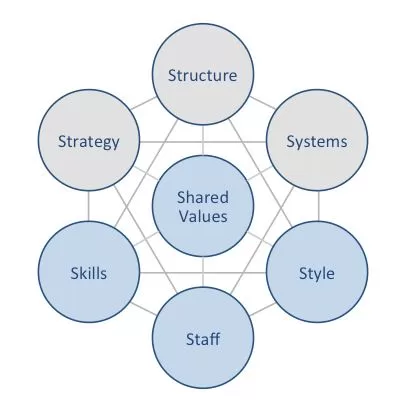 Nvidia McKinsey 7S model illustrates the ways in which seven elements of businesses can be aligned to increase effectiveness. According to the framework strategy, structure and systems represent hard elements, whereas shared values, skills, style and staff are soft elements. McKinsey 7S model stresses the presence of strong links between elements in a way that a change in one element causes changes in others. The model positions shared values are positioned at the core remaining elements, because shared values guide employee behaviour with implications on their performance. McKinsey 7S model Hard Elements in Nvidia McKinsey 7S Model Strategy. Nvidia business strategy benefits from first mover advantage systematically. This has been the case with GPU, Computer Unified Device Architecture (CUDA) and invented deep learning hardware accelerators, such as the Tesla V100 and T4 GPUs and a range of other products. However the sustainability of this strategy in the long-term perspective requires the regular pipeline of new products through effective investment in research and development. Structure. As one of the largest multinational technology companies in the world Nvidia organizational structure integrates the elements of functional and hybrid structures. Within the company business processes are divided into various divisions with highly specialised employees with the relevant skills and competencies attached into respective divisions. Furthermore, the senior management forms temporary project groups to develop new products or for other initiatives and group members report to multiple superiors for the duration of project. Systems. Nvidia depends on a wide range of systems for the business to operate smoothly. These include, but not limited to employee recruitment and selection, team development and orientation, transaction processing, customer relationship management, business intelligence and knowledge management. Each system has its KPIs and controls in place and they are monitored systematically. Nvidia Corporation Report contains a full analysis of Nvidia…
Nvidia McKinsey 7S model illustrates the ways in which seven elements of businesses can be aligned to increase effectiveness. According to the framework strategy, structure and systems represent hard elements, whereas shared values, skills, style and staff are soft elements. McKinsey 7S model stresses the presence of strong links between elements in a way that a change in one element causes changes in others. The model positions shared values are positioned at the core remaining elements, because shared values guide employee behaviour with implications on their performance. McKinsey 7S model Hard Elements in Nvidia McKinsey 7S Model Strategy. Nvidia business strategy benefits from first mover advantage systematically. This has been the case with GPU, Computer Unified Device Architecture (CUDA) and invented deep learning hardware accelerators, such as the Tesla V100 and T4 GPUs and a range of other products. However the sustainability of this strategy in the long-term perspective requires the regular pipeline of new products through effective investment in research and development. Structure. As one of the largest multinational technology companies in the world Nvidia organizational structure integrates the elements of functional and hybrid structures. Within the company business processes are divided into various divisions with highly specialised employees with the relevant skills and competencies attached into respective divisions. Furthermore, the senior management forms temporary project groups to develop new products or for other initiatives and group members report to multiple superiors for the duration of project. Systems. Nvidia depends on a wide range of systems for the business to operate smoothly. These include, but not limited to employee recruitment and selection, team development and orientation, transaction processing, customer relationship management, business intelligence and knowledge management. Each system has its KPIs and controls in place and they are monitored systematically. Nvidia Corporation Report contains a full analysis of Nvidia…Wednesday, June 21, 2023
Nvidia Value Chain Analysis
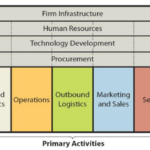 Nvidia value chain analysis is an analytical framework that assists in identifying business activities that can create value and competitive advantage to the business. Specifically, business leaders can create competitive advantage through dividing the business into various activities and analysing each activity individually from value creation perspective. Figure below illustrates the essence of Nvidia value chain analysis. Value chain analysis Primary Activities in Nvidia Value Chain Analysis Nvidia Inbound logistics Nvidia inbound logistics involves managing the supply chain of components and raw materials into the premises of its contract manufacturers. The multinational technology company performs quality checks of semiconductors and other spare parts using test equipment purchased from industry-leading suppliers such as Advantest America Inc. Nvidia benefits from the economies of scale in inbound logistics activities due to the large amount of spare parts and components it purchases. Furthermore, the company has strategic relationships with its key suppliers in place and these relationships play an instrumental role in new product development. Nvidia Operations Nvidia employs fabless manufacturing strategy. It employs third party companies outside of United States for all phases of the manufacturing process, including wafer fabrication, assembly, testing, and packaging.[1] Nvidia does not engage in any of these activities directly and chooses to focus the design, marketing and distribution of its products. The company works with world-class manufacturers to produce its products. Semiconductor wafers are produced by leading companies such as Taiwan Semiconductor Manufacturing Company Limited and Samsung Electronics Co. Ltd, adapter card products and switch systems are produced by the likes of Flex Ltd., Jabil Inc., and Universal Scientific Industrial Co., Ltd. and Fabrinet manufactures Nvidia cables. Assembly, testing and packaging of products and platforms are done by Amkor Technology, King Yuan Electronics Co., Ltd., Omni Logistics, LLC, Siliconware Precision Industries Company Ltd., Wistron Corporation…
Nvidia value chain analysis is an analytical framework that assists in identifying business activities that can create value and competitive advantage to the business. Specifically, business leaders can create competitive advantage through dividing the business into various activities and analysing each activity individually from value creation perspective. Figure below illustrates the essence of Nvidia value chain analysis. Value chain analysis Primary Activities in Nvidia Value Chain Analysis Nvidia Inbound logistics Nvidia inbound logistics involves managing the supply chain of components and raw materials into the premises of its contract manufacturers. The multinational technology company performs quality checks of semiconductors and other spare parts using test equipment purchased from industry-leading suppliers such as Advantest America Inc. Nvidia benefits from the economies of scale in inbound logistics activities due to the large amount of spare parts and components it purchases. Furthermore, the company has strategic relationships with its key suppliers in place and these relationships play an instrumental role in new product development. Nvidia Operations Nvidia employs fabless manufacturing strategy. It employs third party companies outside of United States for all phases of the manufacturing process, including wafer fabrication, assembly, testing, and packaging.[1] Nvidia does not engage in any of these activities directly and chooses to focus the design, marketing and distribution of its products. The company works with world-class manufacturers to produce its products. Semiconductor wafers are produced by leading companies such as Taiwan Semiconductor Manufacturing Company Limited and Samsung Electronics Co. Ltd, adapter card products and switch systems are produced by the likes of Flex Ltd., Jabil Inc., and Universal Scientific Industrial Co., Ltd. and Fabrinet manufactures Nvidia cables. Assembly, testing and packaging of products and platforms are done by Amkor Technology, King Yuan Electronics Co., Ltd., Omni Logistics, LLC, Siliconware Precision Industries Company Ltd., Wistron Corporation…Nvidia Porters Five Forces Analysis
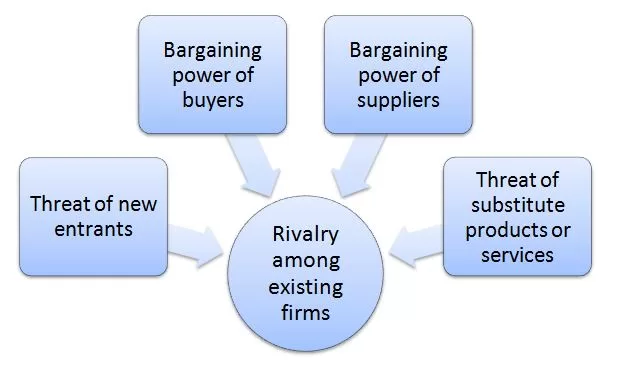 Porter’s Five Forces analytical framework developed by Michael Porter (1979)[1] consists of five individual forces that shape an overall extent of competition in the industry. Nvidia Porters Five Forces are illustrated in figure below: Porter’s Five Forces Threat of new entrants in Nvidia Porter’s Five Forces Analysis Threat of new entrants into graphics processing unit (GPU) industry is low. The below are the main factors that determine the level of threat of new entrants: 1. Time of entry. GPUs are highly saturated market with dominant market players already in the business for decades. Moreover, customer loyalty towards dominant players such as Advanced Micro Devices (AMD, Intel Corporation, Qualcomm Inc., Broadcom Inc. and Arm Holdings (a subsidiary of Softbank Group) is high this fact crates entry barrier for potential market entrants. 2. Massive investments. GPU producing requires massive capital requirements of millions of dollars. It will be very challenging for potential market entrance to secure funding for producing GPUs unless they offer unique competitive advantages with the potential to disrupt the market. 3. Specialist knowledge. GPUs are highly advanced technological products. The production requires highly specialist knowledge and technological know-how. New market entrants will face substantial difficulties in terms of finding employees with specialist knowledge who will agree to join a new company in a highly saturated market. Bargaining power of buyers in Nvidia Porter’s Five Forces Analysis The bargaining power of buyers for Nvidia products is generally insubstantial. The following considerations need to be taken into account in this regard: 1. Switching costs. Nvidia’s products are often integrated into larger systems and it is often difficult to replace these products with similar products produced by competitors due to massive costs and expertise knowledge involved. Such a situation limits buyer bargaining power with positive implications for Nvidia. 2.…
Porter’s Five Forces analytical framework developed by Michael Porter (1979)[1] consists of five individual forces that shape an overall extent of competition in the industry. Nvidia Porters Five Forces are illustrated in figure below: Porter’s Five Forces Threat of new entrants in Nvidia Porter’s Five Forces Analysis Threat of new entrants into graphics processing unit (GPU) industry is low. The below are the main factors that determine the level of threat of new entrants: 1. Time of entry. GPUs are highly saturated market with dominant market players already in the business for decades. Moreover, customer loyalty towards dominant players such as Advanced Micro Devices (AMD, Intel Corporation, Qualcomm Inc., Broadcom Inc. and Arm Holdings (a subsidiary of Softbank Group) is high this fact crates entry barrier for potential market entrants. 2. Massive investments. GPU producing requires massive capital requirements of millions of dollars. It will be very challenging for potential market entrance to secure funding for producing GPUs unless they offer unique competitive advantages with the potential to disrupt the market. 3. Specialist knowledge. GPUs are highly advanced technological products. The production requires highly specialist knowledge and technological know-how. New market entrants will face substantial difficulties in terms of finding employees with specialist knowledge who will agree to join a new company in a highly saturated market. Bargaining power of buyers in Nvidia Porter’s Five Forces Analysis The bargaining power of buyers for Nvidia products is generally insubstantial. The following considerations need to be taken into account in this regard: 1. Switching costs. Nvidia’s products are often integrated into larger systems and it is often difficult to replace these products with similar products produced by competitors due to massive costs and expertise knowledge involved. Such a situation limits buyer bargaining power with positive implications for Nvidia. 2.…Sunday, June 18, 2023
Nvidia Segmentation Targeting & Positioning
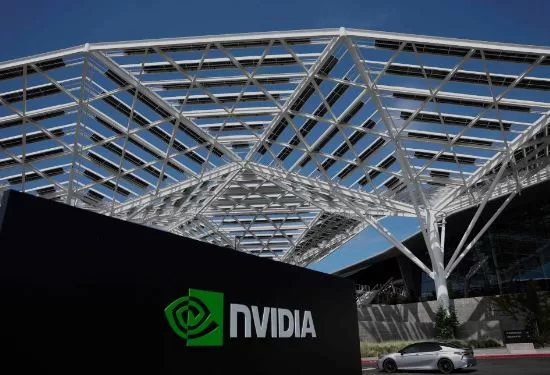 Nvidia segmentation, targeting, and positioning (STP) is a strategic approach to marketing that involves dividing the market into smaller groups of consumers (segmentation), selecting one or more of these groups to target with a specific marketing mix (targeting), and then positioning the product or service in the minds of consumers in a way that differentiates it from the competition (positioning). Nvidia uses the following types of product positioning. – Anticipatory positioning. Anticipatory product positioning is a strategy in which a company positions its products or services in a way that anticipates future trends or needs in the market. Nvidia has used this strategy effectively by positioning its products in a way that anticipates the increasing demand for high-performance computing solutions and emerging technologies such as artificial intelligence and autonomous vehicles. For example, Nvidia recognized in early 1990s the potential of AI and positioned its products accordingly, investing heavily in research and development to create GPUs that are specifically designed to accelerate AI workloads. As a result, Nvidia has become a key player in the AI market, with its GPUs powering many of the most advanced AI applications in industries such as healthcare, finance, and automotive. – Quality product positioning. Quality product positioning is a strategy in which a company positions its products or services as high-quality, reliable, and superior to those of its competitors. Nvidia has used this strategy effectively by emphasizing the quality and reliability of its products and by investing in research and development to continually improve its offerings. Accordingly the company creates high-performance GPUs for a wide range of applications, from gaming to data centre workloads. The following table illustrates Nvidia segmentation, targeting and positioning: Type of segmentation Segmentation criteria Nvidia target customer segment Geographic Region Taiwan, China, United States, other countries Density Urban…
Nvidia segmentation, targeting, and positioning (STP) is a strategic approach to marketing that involves dividing the market into smaller groups of consumers (segmentation), selecting one or more of these groups to target with a specific marketing mix (targeting), and then positioning the product or service in the minds of consumers in a way that differentiates it from the competition (positioning). Nvidia uses the following types of product positioning. – Anticipatory positioning. Anticipatory product positioning is a strategy in which a company positions its products or services in a way that anticipates future trends or needs in the market. Nvidia has used this strategy effectively by positioning its products in a way that anticipates the increasing demand for high-performance computing solutions and emerging technologies such as artificial intelligence and autonomous vehicles. For example, Nvidia recognized in early 1990s the potential of AI and positioned its products accordingly, investing heavily in research and development to create GPUs that are specifically designed to accelerate AI workloads. As a result, Nvidia has become a key player in the AI market, with its GPUs powering many of the most advanced AI applications in industries such as healthcare, finance, and automotive. – Quality product positioning. Quality product positioning is a strategy in which a company positions its products or services as high-quality, reliable, and superior to those of its competitors. Nvidia has used this strategy effectively by emphasizing the quality and reliability of its products and by investing in research and development to continually improve its offerings. Accordingly the company creates high-performance GPUs for a wide range of applications, from gaming to data centre workloads. The following table illustrates Nvidia segmentation, targeting and positioning: Type of segmentation Segmentation criteria Nvidia target customer segment Geographic Region Taiwan, China, United States, other countries Density Urban…Saturday, June 17, 2023
Nvidia Ansoff Matrix
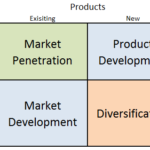 Nvidia Ansoff Matrix is a marketing planning model that helps the GPU producer to determine its product and market strategy. According to Ansoff Matrix there are four different strategy options available for businesses. These are market penetration, product development, market development and diversification. Ansoff Growth Matrix Within the scope of Ansoff Matrix, Nvidia uses all four growth strategies in an integrated manner: 1. Market penetration. Market penetration refers to selling existing products to existing markets. The multinational technology company operates in 32 countries directly and sells its products in many other countries through distributors and re-sellers[1]. Popular market penetration strategies used by Nvidia include print and media advertising, sales promotions, marketing events and experiences, as well as, public relations practices. 2. Product development. This strategy involves developing new products to sell to existing markets. Product development strategy is one of the key growth strategies for Nvidia. In 2021 alone, the company spent over USD 3 billion on R&D, which represented over 20% of its total revenue. Nvidia has invested over USD 29 billion in research and development since its inception.[2] 3. Market development. Market development strategy is associated with finding new markets for existing products and Nvidia uses this strategy to grow the business. Starting only with the US market, the multinational technology company currently operates in 32 countries directly. The company sells its products to many other countries through distributors and re-sellers. 4. Diversification. Diversification involves developing new products to sell to new markets and this is considered to be the riskiest strategy. Nvidia uses diversification extensively, systematically entering new business segments. Starting as 3D graphics producer in 1993, the company expanded product portfolio to produce GPUs in 1999 and immersed itself into AI segment starting from 2012. More recently, Nvidia has further diversified the business to enter cloud…
Nvidia Ansoff Matrix is a marketing planning model that helps the GPU producer to determine its product and market strategy. According to Ansoff Matrix there are four different strategy options available for businesses. These are market penetration, product development, market development and diversification. Ansoff Growth Matrix Within the scope of Ansoff Matrix, Nvidia uses all four growth strategies in an integrated manner: 1. Market penetration. Market penetration refers to selling existing products to existing markets. The multinational technology company operates in 32 countries directly and sells its products in many other countries through distributors and re-sellers[1]. Popular market penetration strategies used by Nvidia include print and media advertising, sales promotions, marketing events and experiences, as well as, public relations practices. 2. Product development. This strategy involves developing new products to sell to existing markets. Product development strategy is one of the key growth strategies for Nvidia. In 2021 alone, the company spent over USD 3 billion on R&D, which represented over 20% of its total revenue. Nvidia has invested over USD 29 billion in research and development since its inception.[2] 3. Market development. Market development strategy is associated with finding new markets for existing products and Nvidia uses this strategy to grow the business. Starting only with the US market, the multinational technology company currently operates in 32 countries directly. The company sells its products to many other countries through distributors and re-sellers. 4. Diversification. Diversification involves developing new products to sell to new markets and this is considered to be the riskiest strategy. Nvidia uses diversification extensively, systematically entering new business segments. Starting as 3D graphics producer in 1993, the company expanded product portfolio to produce GPUs in 1999 and immersed itself into AI segment starting from 2012. More recently, Nvidia has further diversified the business to enter cloud…